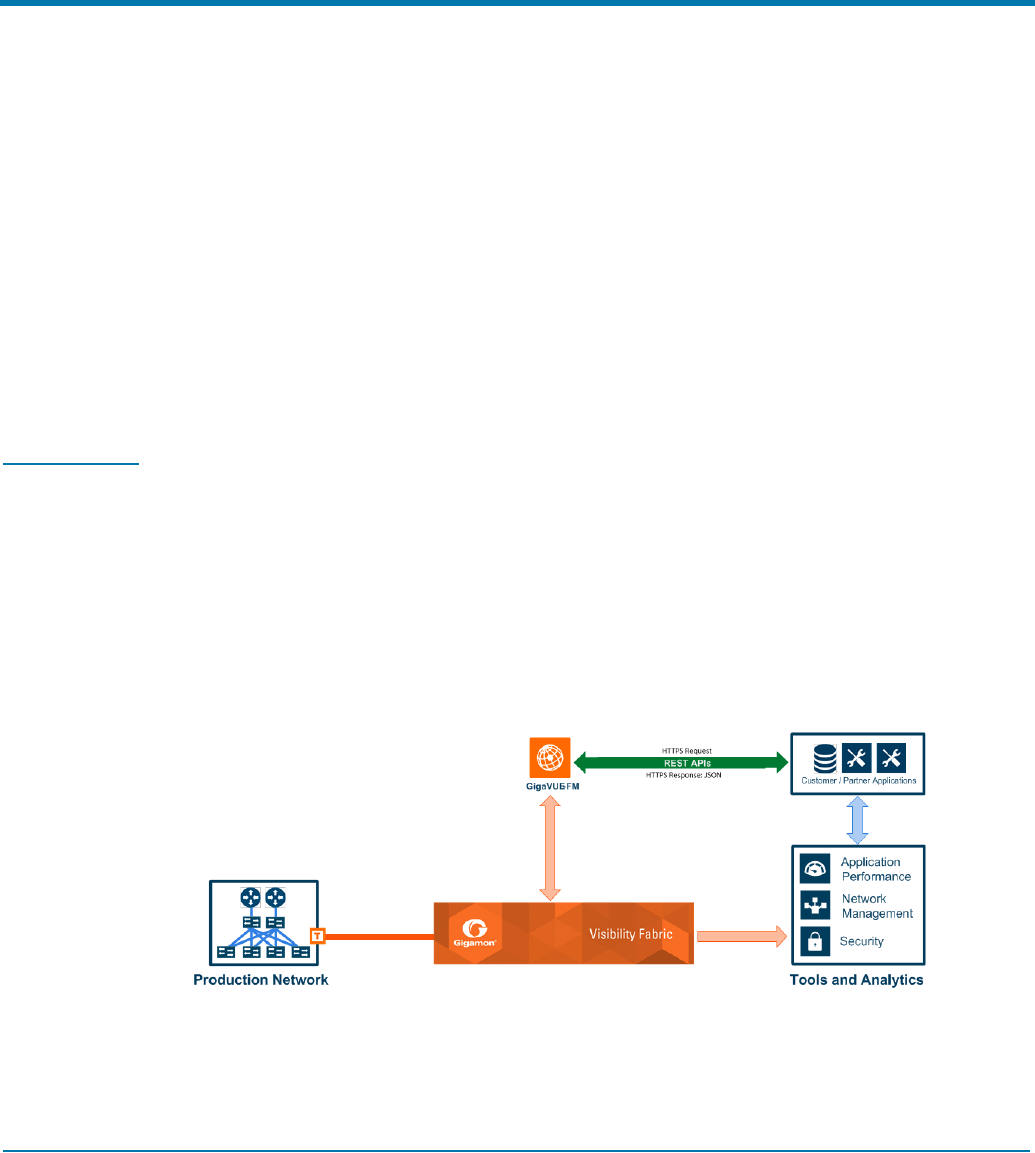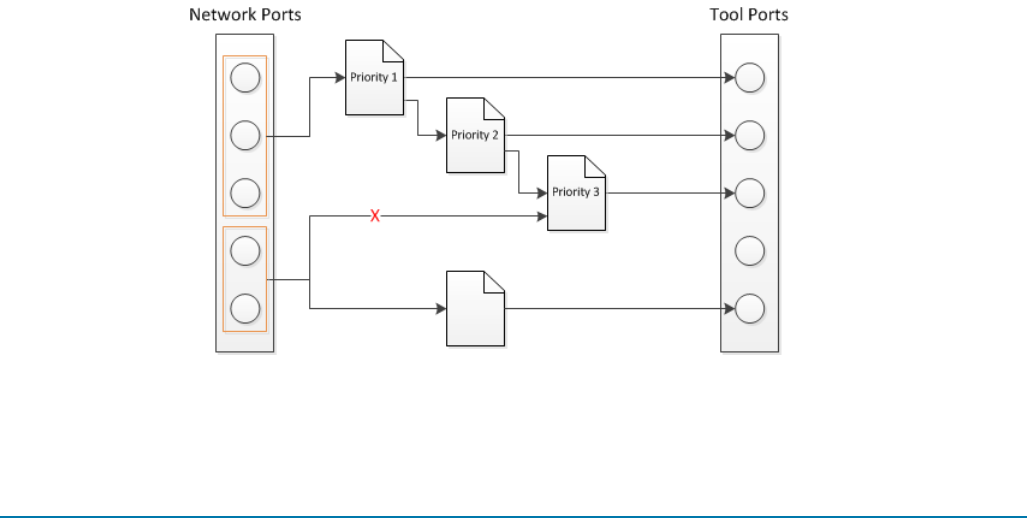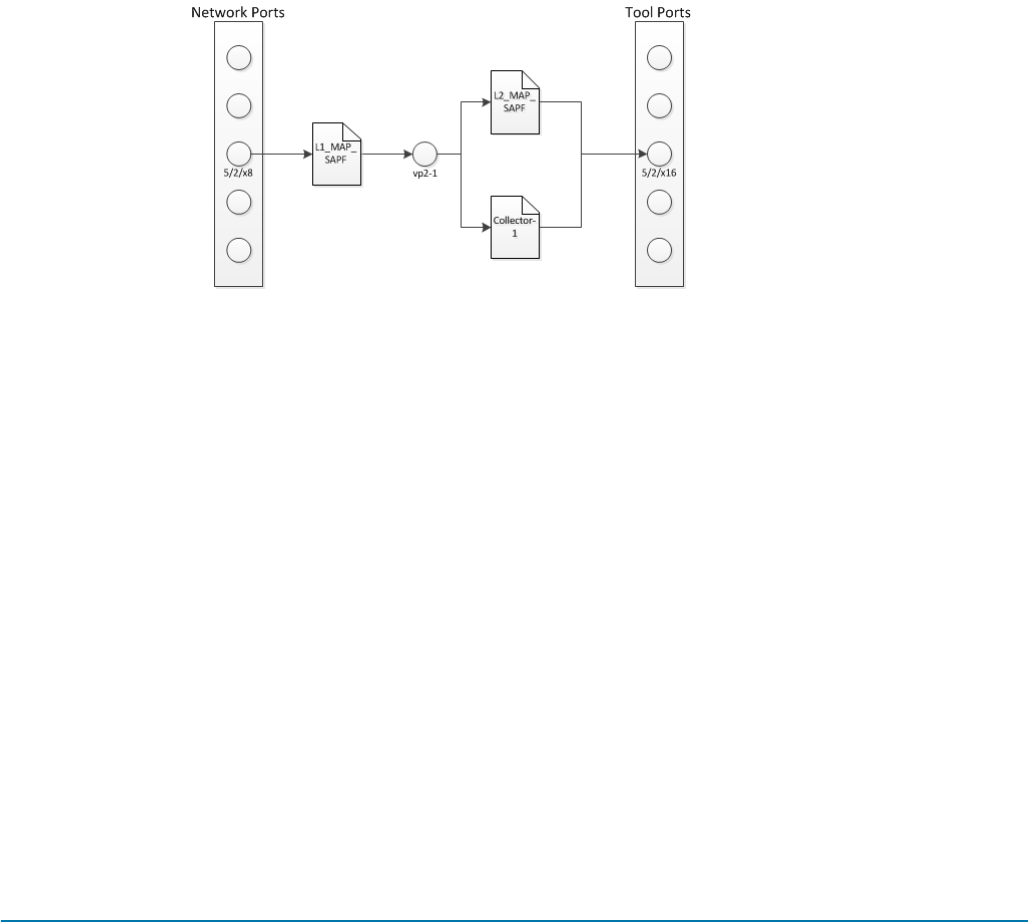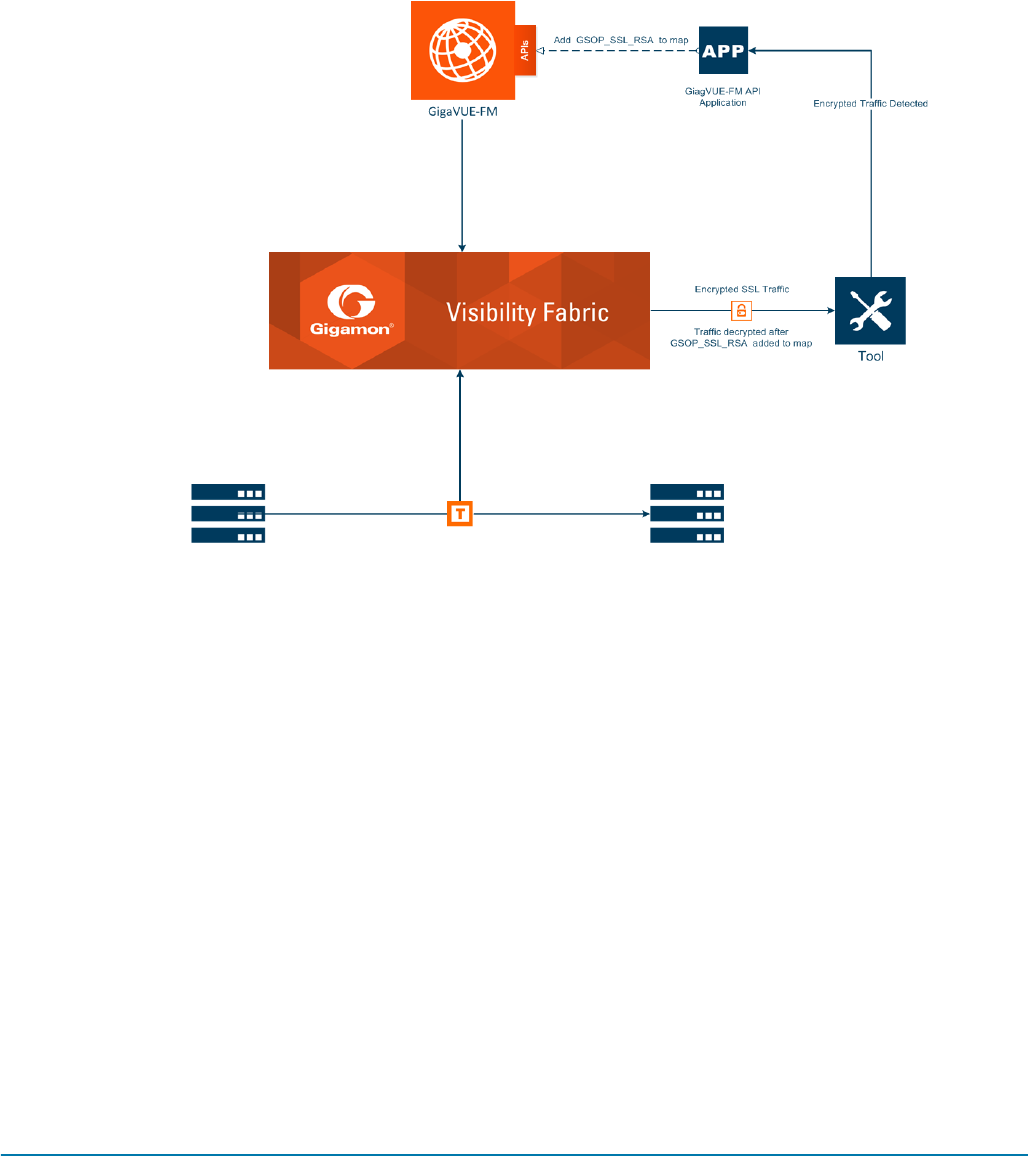
GigaVUE-FM REST API
User’s Guide
GigaVUE-FM 3.5.00
COPYRIGHT
Copyright © 2016 Gigamon. All Rights Reserved. No part of this publication may be reproduced, transmitted,
transcribed, stored in a retrieval system, or translated into any language in any form or by any means without
Gigamon’s written permission.
TRADEMARK ATTRIBUTIONS
Copyright © 2016 Gigamon. All rights reserved. Gigamon and the Gigamon logo are trademarks of Gigamon in
the United States and/or other countries. Gigamon trademarks can be found at www.gigamon.com/legal-
trademarks. All other trademarks are the trademarks of their respective owners.
DOCUMENT REVISION – 12/7/16

Contents © 2016 Gigamon. All rights reserved. 3
Contents
2 About This Guide . . . . . . . . . . . . . . . . . . . . . . . . . . . . . . . . . . . . . . . . . . . . . . . . . . . . . . . . 5
Contacting Technical Support . . . . . . . . . . . . . . . . . . . . . . . . . . . . . . . . . . . . . . . . . . . . . . . . . 6
Premium Support . . . . . . . . . . . . . . . . . . . . . . . . . . . . . . . . . . . . . . . . . . . . . . . . . . . . . . . 6
Contacting Sales . . . . . . . . . . . . . . . . . . . . . . . . . . . . . . . . . . . . . . . . . . . . . . . . . . . . . . . . . . . 6
1 Introduction to the GigaVUE-FM APIs . . . . . . . . . . . . . . . . . . . . . . . . . . . . . . . . . . . . . . 7
Overview . . . . . . . . . . . . . . . . . . . . . . . . . . . . . . . . . . . . . . . . . . . . . . . . . . . . . . . . . . . . . . . . . 7
Installation . . . . . . . . . . . . . . . . . . . . . . . . . . . . . . . . . . . . . . . . . . . . . . . . . . . . . . . . . . . . . . . . 8
What is REST? . . . . . . . . . . . . . . . . . . . . . . . . . . . . . . . . . . . . . . . . . . . . . . . . . . . . . . . . . . . . 8
Authentication . . . . . . . . . . . . . . . . . . . . . . . . . . . . . . . . . . . . . . . . . . . . . . . . . . . . . . . . . . . . . 8
Resources . . . . . . . . . . . . . . . . . . . . . . . . . . . . . . . . . . . . . . . . . . . . . . . . . . . . . . . . . . . . . . . . 9
Links to Resources . . . . . . . . . . . . . . . . . . . . . . . . . . . . . . . . . . . . . . . . . . . . . . . . . . . . . 9
Representation of Resources . . . . . . . . . . . . . . . . . . . . . . . . . . . . . . . . . . . . . . . . . . . . 10
JSON Representation . . . . . . . . . . . . . . . . . . . . . . . . . . . . . . . . . . . . . . . . . . . . . . . . . . 10
GigaVUE-FM Resources . . . . . . . . . . . . . . . . . . . . . . . . . . . . . . . . . . . . . . . . . . . . . . . . . . . . 12
HTTP . . . . . . . . . . . . . . . . . . . . . . . . . . . . . . . . . . . . . . . . . . . . . . . . . . . . . . . . . . . . . . . . . . . 15
HTTP Headers . . . . . . . . . . . . . . . . . . . . . . . . . . . . . . . . . . . . . . . . . . . . . . . . . . . . . . . . 15
HTTP Methods . . . . . . . . . . . . . . . . . . . . . . . . . . . . . . . . . . . . . . . . . . . . . . . . . . . . . . . . 15
GET . . . . . . . . . . . . . . . . . . . . . . . . . . . . . . . . . . . . . . . . . . . . . . . . . . . . . . . . . . . . 16
POST. . . . . . . . . . . . . . . . . . . . . . . . . . . . . . . . . . . . . . . . . . . . . . . . . . . . . . . . . . . 16
PUT . . . . . . . . . . . . . . . . . . . . . . . . . . . . . . . . . . . . . . . . . . . . . . . . . . . . . . . . . . . . 17
PATCH . . . . . . . . . . . . . . . . . . . . . . . . . . . . . . . . . . . . . . . . . . . . . . . . . . . . . . . . . 18
DELETE . . . . . . . . . . . . . . . . . . . . . . . . . . . . . . . . . . . . . . . . . . . . . . . . . . . . . . . . 18
HTTP Status Codes . . . . . . . . . . . . . . . . . . . . . . . . . . . . . . . . . . . . . . . . . . . . . . . . . . . . 19
GigaVUE-FM API Reference . . . . . . . . . . . . . . . . . . . . . . . . . . . . . . . . . . . . . . . . . . . . . . . . . 19
Response Error Messages . . . . . . . . . . . . . . . . . . . . . . . . . . . . . . . . . . . . . . . . . . . . . . . . . . 20
2 GigaVUE-FM API Workflows . . . . . . . . . . . . . . . . . . . . . . . . . . . . . . . . . . . . . . . . . . . . . 33
REST Workflow . . . . . . . . . . . . . . . . . . . . . . . . . . . . . . . . . . . . . . . . . . . . . . . . . . . . . . . . . . . 33
GigaVUE-FM Workflow . . . . . . . . . . . . . . . . . . . . . . . . . . . . . . . . . . . . . . . . . . . . . . . . . . . . . 34
Logging In and Logging Out . . . . . . . . . . . . . . . . . . . . . . . . . . . . . . . . . . . . . . . . . . . . . 34
Managing Physical Nodes . . . . . . . . . . . . . . . . . . . . . . . . . . . . . . . . . . . . . . . . . . . . . . . 34
Adding Nodes . . . . . . . . . . . . . . . . . . . . . . . . . . . . . . . . . . . . . . . . . . . . . . . . . . . . 34
Getting Node Information . . . . . . . . . . . . . . . . . . . . . . . . . . . . . . . . . . . . . . . . . . . 35
Deleting Clusters or Nodes . . . . . . . . . . . . . . . . . . . . . . . . . . . . . . . . . . . . . . . . . . 35
Configuring Ports . . . . . . . . . . . . . . . . . . . . . . . . . . . . . . . . . . . . . . . . . . . . . . . . . . . . . . 35
Getting Port Information . . . . . . . . . . . . . . . . . . . . . . . . . . . . . . . . . . . . . . . . . . . . 36
Setting the Port Type and Enabling. . . . . . . . . . . . . . . . . . . . . . . . . . . . . . . . . . . . 37

4 © 2016 Gigamon. All rights reserved. GigaVUE-FM REST API Getting Started
Creating Port Groups. . . . . . . . . . . . . . . . . . . . . . . . . . . . . . . . . . . . . . . . . . . . . . . 37
Getting Port Group Information . . . . . . . . . . . . . . . . . . . . . . . . . . . . . . . . . . . . . . . 37
Updating Port Groups . . . . . . . . . . . . . . . . . . . . . . . . . . . . . . . . . . . . . . . . . . . . . . 37
Deleting a Port Group . . . . . . . . . . . . . . . . . . . . . . . . . . . . . . . . . . . . . . . . . . . . . . 38
Creating GigaStream. . . . . . . . . . . . . . . . . . . . . . . . . . . . . . . . . . . . . . . . . . . . . . . 38
Getting GigaStream Information . . . . . . . . . . . . . . . . . . . . . . . . . . . . . . . . . . . . . . 38
Deleting GigaStream . . . . . . . . . . . . . . . . . . . . . . . . . . . . . . . . . . . . . . . . . . . . . . . 38
Configuring Traffic Maps . . . . . . . . . . . . . . . . . . . . . . . . . . . . . . . . . . . . . . . . . . . . . . . . 39
Working with Maps . . . . . . . . . . . . . . . . . . . . . . . . . . . . . . . . . . . . . . . . . . . . . . . . 39
Working with Rules . . . . . . . . . . . . . . . . . . . . . . . . . . . . . . . . . . . . . . . . . . . . . . . . 42
Working with GigaSMART Groups and Operations . . . . . . . . . . . . . . . . . . . . . . . 43
3 Working with GigaVUE-FM APIs . . . . . . . . . . . . . . . . . . . . . . . . . . . . . . . . . . . . . . . . . . 47
Working with Nodes . . . . . . . . . . . . . . . . . . . . . . . . . . . . . . . . . . . . . . . . . . . . . . . . . . . . . . . . 47
Adding Nodes . . . . . . . . . . . . . . . . . . . . . . . . . . . . . . . . . . . . . . . . . . . . . . . . . . . . . . . . 47
Getting Node Information . . . . . . . . . . . . . . . . . . . . . . . . . . . . . . . . . . . . . . . . . . . . . . . . 48
Getting Chassis Information . . . . . . . . . . . . . . . . . . . . . . . . . . . . . . . . . . . . . . . . . . . . . . 51
Working with Ports . . . . . . . . . . . . . . . . . . . . . . . . . . . . . . . . . . . . . . . . . . . . . . . . . . . . . . . . . 53
Getting Port Information . . . . . . . . . . . . . . . . . . . . . . . . . . . . . . . . . . . . . . . . . . . . . . . . . 53
Changing the Port Type and Enabling . . . . . . . . . . . . . . . . . . . . . . . . . . . . . . . . . . . . . . 53
Creating, Modifying, and Deleting Maps . . . . . . . . . . . . . . . . . . . . . . . . . . . . . . . . . . . . . . . . 54
Creating Maps . . . . . . . . . . . . . . . . . . . . . . . . . . . . . . . . . . . . . . . . . . . . . . . . . . . . . . . . 55
Creating a Map By Rule . . . . . . . . . . . . . . . . . . . . . . . . . . . . . . . . . . . . . . . . . . . . 55
Creating Maps for Dropping Traffic on a Session . . . . . . . . . . . . . . . . . . . . . . . . . 56
Creating Maps for Masking Data . . . . . . . . . . . . . . . . . . . . . . . . . . . . . . . . . . . . . . 58
Modifying Maps . . . . . . . . . . . . . . . . . . . . . . . . . . . . . . . . . . . . . . . . . . . . . . . . . . . . . . . 60
Deleting Maps . . . . . . . . . . . . . . . . . . . . . . . . . . . . . . . . . . . . . . . . . . . . . . . . . . . . . . . . 62
4 GigaVUE-FM API Reference . . . . . . . . . . . . . . . . . . . . . . . . . . . . . . . . . . . . . . . . . . . . . 63

About This Guide © 2016 Gigamon. All rights reserved. 5
About This Guide
This guide is an introduction to the Application Program Interfaces (APIs) for the
GigaVUE
®
Fabric Manager (GigaVUE-FM) and provides an overview of these REST
APIs, basic work flows, and use cases. The APIs are implemented with the
Representational State Transfer (REST) architecture.
Audience
This guide is intended for application developers interested in developing tools with the
GigaVUE-FM APIs. Technical personnel familiar with a scripting or programming
language can also use this guide. Familiarity with HTTP is a prerequisite to using the
APIs.
Other Sources of Information
Gigamon provides additional documentation for the GigaVUE Fabric Manager (FM) on
the Gigamon Customer Portal:
Document Summary
GigaVUE-FM User’s Guide Describes how to install, deploy, and operate the GigaVUE-FM fabric
management system.
GigaVUE-FM Release Notes Describes new features and known issues in the release.
GigaVUE-FM API Reference Describes the GigaVUE-FM REST APIs.
Visibility Platform for AWS Getting
Started Guide
Describes how to deploy and configure the Visibility Platform for
Amazon Web Services (AWS) with GigaVUE-FM.
GigaVUE-OS CLI User’s Guide Describes how to configure and operate the GigaVUE-OS software
from the command-line interface.

6 © 2016 Gigamon. All rights reserved. GigaVUE-FM REST API User’s Guide
Contacting Technical Support
Refer to http://www.gigamon.com/support-and-services/contact-support for Technical
Support hours and contact information. You can also email Technical Support at
suppor[email protected].
Premium Support
Email Gigamon at [email protected] for information on purchasing 24x7
Premium Support for your GigaVUE Traffic Visibility Node. Premium Support entitles
you to round-the-clock phone support with a dedicated Support Engineer every day of
the week.
Contacting Sales
Telephone: +1.408.831.4025
Sales: inside.sale[email protected]

Introduction to the GigaVUE-FM APIs © 2016 Gigamon. All rights reserved. 7
1 Introduction to the GigaVUE-FM APIs
This chapter provides an introduction to the GigaVUE-FM APIs, which are designed
with the Representational State Transfer (REST) architecture. Refer to the following
sections:
• Overview on page 7
• Installation on page 8
• What is REST? on page 8
• Authentication on page 8
• Resources on page 9
• GigaVUE-FM Resources on page 12
• HTTP on page 15
• GigaVUE-FM API Reference on page 19
Overview
The GigaVUE-FM APIs provide a well structured architecture for performing query,
update, and delete functions in a programmatic manner.
The APIs use the REST architecture, which makes it possible to create client
applications that are platform- and language-independent. REST applications can use
the APIs to perform various tasks with GigaVUE-FM by making requests and receiving
responses as shown in Figure 1-1.
Figure 1-1: APIs and GigaVUE-FM

8 © 2016 Gigamon. All rights reserved. GigaVUE-FM REST API Getting Started
Applications that implement the GigaVUE-FM APIs can do the following:
• Improve security through better network detection, reaction, and response by
automating NetFlow generation and SSL decryption so that current security
appliances are not overtaxed when performing deep packet inspection. For
example, security administrators can use the APIs that program the Visibility Fabric
to dynamically change the traffic forwarding policies in response to threats or
anomalous network traffic changes.
• For many organizations, IT Operations Management (ITOM) groups can use the
APIs to develop programs that automate the following processes through
software-defined visibility:
• Performing common tasks, such as provisioning and ticketing of network port
configurations.
• Monitoring new IP subnets and VLANs.
• Upgrading software images.
Installation
For support and installation instructions, refer to the GigaVUE-FM and GigaVUE-VM
User’s Guide.
What is REST?
REST is an architectural style that relies on a client-server communication protocol that
is stateless. It is assumed that the client and server do not know anything about the
state of an object other than what is communicated in requests and responses. Objects
are identified by a uniform resource identifier (URI). Objects represent resources, and
the URI provides a link to the resource. The state of a resource is communicated by
structured documents passed between the client and the server.
GigaVUE-FM APIs use HTTP as the communication protocol to communicate with the
GigaVUE Fabric Manager (FM). Therefore, anyone who is creating applications should
be familiar with the HTTP protocol before creating clients that use the APIs.
Another important concept is Hypermedia as the Engine of State (HATEOS). HATEOS
is a constraint on the REST architecture. This constraint states that hypertext is used to
change the state of an application and allows the application to navigate through an
API.
Authentication
Authentication must accompany each request that an application makes to
GigaVUE-FM. The authentication is contained in the authorization header of the
request. (For more information about headers, refer to HTTP Headers on page 15.)
The APIs only support Basic authorization. Basic authorization uses unencrypted
base64 encoded text to send the user name and password in the request.

Introduction to the GigaVUE-FM APIs © 2016 Gigamon. All rights reserved. 9
The following is an example of using base64 encoding to encode a user name and
password:
encoding = base64.base64encode('username1:password1')
print encoding
dXNlcm5hbWU6cGFzc3dvcmQ=
Notes:
• When an application logs in to GigaVUE-FM to make a request, the application
should also log out after the request is complete. Otherwise, too many user
sessions may be created and an invalid credential error message returned if the
current request exceeds the maximum number of user sessions.
• Starting with GigaVUE-OS 4.7.00, the default admin password admin123A! is no
longer allowed on nodes. When authenticating through the APIs against a node
that is running GigaVUE-OS 4.7.00 or later, if admin123A! is used, the
authentication will not complete.
Resources
Resources are a key component in REST and represent an object within a system.
They are associated with data and have relationships to other resources. There is also
a set of methods that operate on a resource.
The following sections provide an overview of these resources and the resources an
application can access through GigaVUE-FM:
• Links to Resources on page 9
• Representation of Resources on page 10
• JSON Representation on page 10
• HTTP Headers on page 15
• HTTP Methods on page 15
Links to Resources
A uniform resource identifier (URI) provides the link to a resource. The URI consists of
a base URI and a request URI. The base URI for GigaVUE-FM APIs is as follows,
where
<fmip> is the IP address for GigaVUE-FM and <api_version> is the current
version of the API:
<fmip>/api/<api_version>
The request URI is the portion of the URI used to perform an HTTP request. For
example:
/inventory/ports
A complete URI is:
<fmip>/api/v1.3/inventory/ports

10 © 2016 Gigamon. All rights reserved. GigaVUE-FM REST API Getting Started
NOTE: You can use the API GET <fmip>/api/version to get the current API version.
This API returns the following content in JSON format:
{"apiVersion": "v1.3", "schemaVersion": "v1.3"}
Representation of Resources
GigaVUE-FM REST APIs use JavaScript object notation (JSON) to represent
resources in a structured document. This representation is used in the request and
response bodies of API calls. The default format is JSON and the GigaVUE-FM API
Reference provides JSON models and model schema to describe response classes
and request bodies. For information on how to access the reference, refer to
GigaVUE-FM API Reference on page 19.
When a client makes a request to a resource, the request specifies that it is using
JSON in the request and that the response should return data in JSON. The format is
specified in the header of the request. For more information about headers, see HTTP
Headers on page 15.
JSON Representation
JSON is a language-independent data format that is considered easy to read and write.
The data is provided as a collection of unordered name/value pairs and ordered lists of
values. The
name/value pairs can be viewed as a dictionary and the ordered list of values as an
array.
For example, the following represents port information in JSON format returned in a
response body as the result of a query to the resource
/inventory/ports:
{
"context" : {
"totalItems" : 59
},
"ports" : [ {
"portId" : "5/2/x4",
"comment" : "",
"portType" : "tool",
"adminStatus" : "down",
"operStatus" : "down",
"licensed" : true,
"medium" : "OPTICAL",
"configSpeed" : "10G",
"duplex" : "full",
"autoNeg" : false,
"forceLinkUp" : false,
"mtu" : 9600,
"healthState" : "green",
"neighborDiscovery" : "none"
}, {
"portId" : "5/2/x12",
"comment" : "",

Introduction to the GigaVUE-FM APIs © 2016 Gigamon. All rights reserved. 11
"portType" : "network",
"adminStatus" : "down",
"operStatus" : "down",
"licensed" : true,
"medium" : "OPTICAL",
"configSpeed" : "10G",
"duplex" : "full",
"autoNeg" : false,
"forceLinkUp" : false,
"mtu" : 9600,
"healthState" : "green",
"neighborDiscovery" : "none"
}, ...
]
}
Because the data can be viewed as dictionaries and arrays, it is easy to extract the
information from a response. For example, the following code processes the JSON
document and prints the administrative and operational status of ports with an
administrative status of up:
portInfo = json.loads(r.text)
ports = portInfo['ports']
for port in ports:
adminStatus = port['adminStatus']
operStatus = port ['operStatus']
if adminStatus == 'up':
print 'Port ID: ' + port['portId']
print ' Admin Status: ' + port['adminStatus']
print ' Op Status: ' + port['operStatus']
In JSON, the collection of name/value pairs is referred to as an object, and the ordered
collection of values is referred to as an array. In the previous code example, the
json.loads function converts the JSON object into a dictionary.
Values are separated by commas and can be any of the following:
• A string in double quotes
• A number
• An object
• An array
•True
•False
•Null

12 © 2016 Gigamon. All rights reserved. GigaVUE-FM REST API Getting Started
GigaVUE-FM Resources
The GigaVUE-FM APIs provide much of the same functionality as the GigaVUE-OS
CLI commands. Tabl e 1 -1 lists the available resources by their root and the CLI
commands that provide a similar functionality as the APIs for a given resource. (For
detailed information about the CLI commands, refer to the GigaVUE-OS CLI User’s
Guide. The base URI for the resources when making a request is
<fmip>/api/v3.1.
For more information about URIs, refer to Links to Resources on page 9.
Table 1-1: API Resources and CLI Commands
Resource Description CLI Command
/nodes Node management FM only
/nodeCredentials Credentials for managed physical nodes FM only
/inventory/chassis Device chassis configuration
show chassis
/inventory/ports Device port configuration
show port
/portConfig/portConfigs Port configuration
port
/portConfig/portGroups Port group configuration
port-group
/portConfig/gigastreams GigaStream configuration
gigastream
/portConfig/portPairs Port-pair configuration
port-pair
/portConfig/toolPortMirrors Tool port mirror configuration
tool-mirror
/portConfig/toolPortFilters Tool port filter configuration
port filter rule
/portConfig/stackLinks Stack links configuration
stack-link
/portConfig/tunneledPorts Tunneled port configuration
tunneled-port
/maps Maps and map rules configuration
map
/mapChains Map chain configuration FM only
/mapTemplates Map template configuration
map-template
/gsGroups GigaSMART group configuration
gsgroup
/gsops GigaSMART operations configuration
gsop
/vports Virtual port configuration
vport
/apps/netflow Netflow exporter, record, and monitor
configuration
apps netflow
/apps/ssl Secure Socket Layer (SSL) decryption
keystore and decryption key configuration
apps ssl
/apps/gtp/whitelists GTP Whitelist operations
apps gtp-whitelist
/apps/saApfProfiles Session-aware APF profile configuration
apps sapf
/inline/networks Inline network configuration
inline-network
/inline/networkGroups Inline network group configuration
inline-network-group
/inline/tools Inline tool configuration
inline-tool
/inline/toolGroups Inline tool group configuration
inline-tool-group

Introduction to the GigaVUE-FM APIs © 2016 Gigamon. All rights reserved. 13
/inline/serialToolGroups Inline tool series configuration
inline-serial
/inline/hbProfiles Heartbeat profile configuration
hb-profile
/inline/negativeHbProfiles Negative heartbeat profile configuration
inline-tool
negative-heart-beat
/inline/hbPackets Heartbeat packet upload configuration
hb-profile custom-packet
hb-profile packet-format
/inline/reduncancyProfiles Inline tool group redundancy
inline-network
/system/config Configuration files upload and download
configuration fetch
configuration upload
/system/config/text Text configuration files
configuration text
/system/sysdump Sysdump file generation, download, and
delete
debug generate dump
/system/time Time settings
ntp, ptp
/system/syslogs Syslog retrieval and update
logging
/system/localUsers Local user account management
username
/system/security System security policy settings
system
/system/aaa Authorization and roles
aaa authentication
system/ldapServers LDAP servers for authentication
ldap
/system/radiusServers RADIUS servers for authentication
radius-server
/system/tacacsServers TACACS+ servers for authentication
tacacs-server
/system/snmp SNMP settings, v3 users, notification
targets
snmp-server host
/system/email/notifications Email notification settings
email
/system/uboot Install binary bootloader code included
with the active/booted image
uboot install
/clusterConfig Physical cluster reboot and image upgrade
reload
/system/interfaces Retrieve system interface information
show interface
/scheduledTasks Retrieve scheduled tasks, schedule cluster
configuration backups, and delete
scheduled tasks.
FM only
/imageServers Image file servers FM only
/licensing Licensing management for FM FM only
/events Manage events FM only
/auditLog Audit log of user actions on FM FM only
/trending Time series information for ports, maps,
GS groups, virtual ports, GVM ports, and
GVM maps
FM only
Table 1-1: API Resources and CLI Commands
Resource Description CLI Command

14 © 2016 Gigamon. All rights reserved. GigaVUE-FM REST API Getting Started
Starting with GigaVUE-FM 3.5, Public Cloud Visibility APIs are available for use with
the Gigamon Visibility Platform for AWS. These resources do not have any equivalent
CLI commands. Tabl e 1 -2 lists the resources for Public Cloud Visibility. For details
about these APIs, refer to the GigaVUE-FM 3.5 API Reference.
/trafficAnalyzer Flow mapping analytics for dropped traffic FM only
/tunnelEndpoints Tunnel endpoint information
tunneled-port
/topology Create, update, and delete manual nodes
and links in Topology Visualization
FM only
/fmSystem Reboot, backup, and restore
GigaVUE-FM. Provide the image server
and file path to the upgrade image on the
server.
FM only
/fmSystem/archiveServers Manage archive server and archive files. FM only
Table 1-2: Gigamon Visibility Platform for AWS API Resources
Resource Description
vmm/ats/vms Retrieve a list of VMs selected for a monitoring session.
vmm/configParams Retrieve or modify configuration parameters.
vmm/tunnelSpecs Retrieve, created, modify, or delete tunnel specification.
vmm/tunnelEndpoints Retrieve tunnel endpoints.
vmm/maps Retrieve, create, modify, or delete maps.
vmm/mapFolders Retrieve, created, modify, or delete map folders and retrieve maps
associated with a folder.
vmm/monitoringSessions Retrieve, created, modify, or delete monitoring sessions.
vmm/stats Retrieve monitoring session traffic statistics.
vmm/apps Retrieve, register, update, or delete GigaSMART applications.
vmm/aws/connections Retrieve, updated, add, or connect to AWS connections.
vmm/aws/inventory Retrieve AWS inventory or rediscovery AWS inventory.
vmm/aws/gvTapControllers Retrieve, add, modify, or deleted G-vTAP controller launch
specifications and retrieve G-vTAP controllers.
vmm/aws/vseriesControllers Retrieve, add, modify, or deleted V Series controller launch
specifications and retrieve V Series controllers.
vmm/aws/vseriesNodes Retrieve, add, modify, or deleted V Series node launch specifications
and retrieve V Series nodes.
Table 1-1: API Resources and CLI Commands
Resource Description CLI Command

Introduction to the GigaVUE-FM APIs © 2016 Gigamon. All rights reserved. 15
HTTP
The Hypertext Transfer Protocol (HTTP) is the protocol used in REST for
communication between the client and the server. This section provides a description
of the HTTP methods supported by the GigaVUE-FM APIs, HTTP headers, and status
codes that can be returned in response to a request.
This section covers the following topics:
• HTTP Headers on page 15
• HTTP Methods on page 15
• HTTP Status Codes on page 19
HTTP Headers
HTTP headers are part of requests and responses and provide information about the
client and the server. The headers contain authorization information and specify the
format of the content in a request or response body.
The following are the basic headers:
• Authorization—Specifies the authentication used in the request. Basic
authorization sends the user name and password as unencrypted base64 encoded
text. Digest authorization sends the password to the server in a hashed form. (The
GigaVUE-FM APIs use only Basic authorization.)
• Accept—Specifies the format of the data expected in the response to a request.
• Content-Type—Specifies the format of the data in a request or response body. This
header is used in POST, PUT, and PATCH operations. It is not used with a GET
operation.
• Content-Length—Specifies the number of bytes in the content body of a request.
N
OTE: In the current release, the Content-Type and Accept headers should always
specify
application/json.
HTTP Methods
REST applications use HTTP methods to perform create, read, update, and delete
operations on resources, otherwise known as CRUD operations. The GigaVUE-FM
REST APIs support the following HTTP methods:
• GET
• POST
• PUT
• PAT CH
• DELETE
These operations are idempotent. In the context of REST, this means that the same
request always produces the same result on the server. However, the response from
the server may be different because it may have changed state between requests.

16 © 2016 Gigamon. All rights reserved. GigaVUE-FM REST API Getting Started
GET
A GET operation requests a resource for a representation of that resource. GET requests
only retrieve data.
The following example retrieves a port by port ID:
GET <fmip>/api/<api_version>/inventory/ports/5_2_x8
Authorization: Basic 'dXNlcm5hbWU6cGFzc3dvcmQ='
Accept: application/json
The previous request returns the following response in JSON format:
{
"port" : {
"portId" : "5/2/x8",
"alias" : "Map_Source",
"comment" : "",
"portType" : "network",
"adminStatus" : "up",
"operStatus" : "up",
"licensed" : true,
"medium" : "OPTICAL",
"sfp" : {
"sfpType" : "sfp+ sr",
"sfpPower" : " -1.86 ",
"vendorName" : "GIGAMON SFP-532",
"vendorSn" : "APM0M2D ",
"vendorPn" : "GMON8571D3BCL-G"
},
"configSpeed" : "10G",
"duplex" : "full",
"autoNeg" : false,
"forceLinkUp" : false,
"mtu" : 9600,
}
}
POST
A POST operation creates a new resource. The resource is created at the location
specified in the request. For example, the following request adds a GigaSMART
operation at
/api/<api_version>/gsops:
POST <fmip>/api/<api_version>/gsops?clusterId=10.115.152.54
Authorization: Basic 'dXNlcm5hbWU6cGFzc3dvcmQ='
Content-Type : application/json
Accept : application/json
Content-Length : 129
The following is an example of a body used in the previous request:
{
"alias" : "masking",
"gsGroup" : "GS1",
"gsApps" : {
"masking" : {

Introduction to the GigaVUE-FM APIs © 2016 Gigamon. All rights reserved. 17
"protocol" : "tcp",
"offset" : 4,
"pattern" : "b" ,
"length" : 13
}
}
}
PUT
A PUT operation modifies a resource with data provided in the request. The resource is
created with the given data at the URI in the request if the resource does not already
exist.
For example, the following request replaces an existing map definition defined by its
alias.
PUT <fmip>/api/<api_version>/maps/AASlice_Level1
Authorization: Basic 'dXNlcm5hbWU6cGFzc3dvcmQ='
Content-Type : application/json
Accept: application/json
Content-Length : 597
The following is an example of a body used in the previous request:
{
"maps" : [ {
"alias" : "AASlice_Level1",
"clusterName" : "10.115.152.54",
"type" : "firstLevel",
"subType" : "byRule",
"srcPorts" : [ "10/1/g10", "10/1/g11", "10/1/g12", "10/1/g13"],
"dstPorts" : [ "vp" ],
"order" : 1,
"rules" : {
"dropRules" : [ ],
"passRules" : [ {
"ruleId" : 1,
"bidi" : true,
"matches" : [ {
"type" : "portSrc",
"value" : 80
} ]
}, {
"ruleId" : 2,
"bidi" : true,
"matches" : [ {
"type" : "portSrc",
"value" : 20
} ]
}, {
"ruleId" : 3,
"bidi" : true,
"matches" : [ {

18 © 2016 Gigamon. All rights reserved. GigaVUE-FM REST API Getting Started
"type" : "portSrc",
"value" : 21
} ]
} ]
},
"roles" : {
"owners" : [ "admin" ],
"viewers" : [ ],
"editors" : [ ],
"listeners" : [ ]
}
} ]
}
PATCH
A PATCH operation modifies individual properties of a resource according to the
instructions in the request.
For example, the following request changes a tool port to a network port and enables
the administrative status:
PATCH <fmip>/api/<api_version>/inventory/ports/3_1_x1
Authorization: Basic 'dXNlcm5hbWU6cGFzc3dvcmQ='
Content-Type: application/json
Accept: application/json
Content-Length : 62
The following is an example of the body used in the previous request:
{
'adminStatus': 'up',
'portType': 'network',
'portId': '3/1/x1'
}
DELETE
A DELETE operation removes a resource.
For example, the following request deletes a map by its alias:
DELETE <fmip>/api/<api_version>/maps/AASlice_Level1
Authorization: Basic 'dXNlcm5hbWU6cGFzc3dvcmQ='
Content-Type: application/json
Accept: application/json

Introduction to the GigaVUE-FM APIs © 2016 Gigamon. All rights reserved. 19
HTTP Status Codes
A response to a request provides a status code indicating to the client whether the
request was successful or failed. Ta ble 1 - 3 lists some of the status codes that the
GigaVUE-FM APIs can return.
For 400 and 500 series status codes, the response from GigaVUE-FM contains a body
in JSON format that provides a description of the error.
GigaVUE-FM API Reference
You can access the descriptions of the GigVUE-FM Core APIs from GigaVUE-FM by
clicking on the appropriate link under
Support. The help page lists the APIs for the
different types of operations. Each description provides the methods available, the
JSON model and model schema for the requests and responses, and the applicable
HTTP status codes returned in error messages. You can also connect to the on-line
GigaVUE-FM API Reference through the following URL:
<FM IP address>/apiref/apiref.html
Table 1-3: HTTP Status Codes
Status Code Meaning
200 OK The request succeeded.
201 Created The request was accepted and a new resource was created.
202 Accepted The server accepted the request.
204 No Content The response did not have any content.
400 Bad Request The request is invalid.
401 Unauthorized The request was not authenticated.
403 Forbidden Access denied.
404 Not Found The entity was not found.
409 Conflict The entity already exists.
500 Internal Server An error occurred on the server.

20 © 2016 Gigamon. All rights reserved. GigaVUE-FM REST API Getting Started
Response Error Messages
Starting with GigaVUE-FM version 3.4, REST API requests return a global error
message if an error occurs. Prior to GigaVUE-FM version 3.4, if an error occurred the
error message presented was the error returned by the device, which could vary from
device to device for the same error condition. The global error message returned by
GigaVUE-FM APIs have an error response body that contains a unique code and a
message. The following is an example:
"errors": [{
"code":"0x800200b",
"msg": “Invalid alias 'Test Space'. ''is a reserved character."
}]
The following tables list the possible error codes and their descriptions.
Table 1-4: Gigamon Device Error Codes
Error Code Description
0x80020000 initialization failure
0x80020001 TMS internal failure
0x80020002 Null Objects
0x80020003 No more resource
0x80020004 uninitialized param
0x80020005 Unsupported Product Code
0x80020006 Unsupported Operation
0x80020007 Configuration Failed
0x80020008 Configuration exists
0x80020009 Configuration not found
0x8002000a Operation not allowed on reserved object
0x8002000b invalid argument
0x8002000c invalid net addr/mask
0x8002000d invalid ip addr/mask
0x8002000e GV DB query failed
0x8002000f GVO internal failure
0x80020010 Objects exceeds maximum range
0x80020011 Config in progress
0x80020012 User invalid
0x80020013 User role Invalid
0x80020014 User Permission Insufficent for Operation
0x80020015 Unlicensed Feature

Introduction to the GigaVUE-FM APIs © 2016 Gigamon. All rights reserved. 21
0x80020016 Feature License expired
0x80020017 Chassis is in SAFE mode! No new traffic configuration is allowed.
0x80020018 Chassis is in LIMITED mode! The configuration is not allowed.
0x80020020 Chassis not valid
0x80020021 Card not valid
0x80020022 Card Mode Invalid
0x80020023 Slot not valid
0x80020024 Slot State Invalid
0x80020025 Slot not configured
0x80020026 Unconfigured box-id
0x80020027 Chassis mode is not supported
0x80020028 CC card does not support this card
0x80020030 Port Invalid
0x80020031 Port Type Invalid
0x80020032 Port not configured
0x80020033 Port Mode Invalid
0x80020034 Port Inactive
0x80020035 Port SFP Unsupported
0x80020036 Port Config is invalid
0x80020037 Port Config exists
0x80020038 Port conflict in config
0x80020039 Portpair update disallowed. Config exists
0x8002003a Portpair object mismatch
0x8002003b Portpair cross-box not supported
0x8002003c Portpair cross-card not supported
0x8002003d Portpair with tunnel not supported
0x8002003e Portpair Linktimer failed
0x8002003f Port Group in Use
0x80020040 Port Group Object Mismatch
0x80020041 Port Group has Tunnel config
0x80020042 Port Group resource exceeds range
0x80020043 Stacklink in Use
0x80020044 Stacklinks cannot be in same box
Table 1-4: Gigamon Device Error Codes
Error Code Description

22 © 2016 Gigamon. All rights reserved. GigaVUE-FM REST API Getting Started
0x80020045 Stacklinks not found
0x80020046 Stacklinks will cause loops
0x80020047 Port in Use
0x80020048 Invalid port to break out
0x80020060 GSOP required for operation
0x80020061 GSOP SSL requires order of operation
0x80020062 GSOP invalid
0x80020063 GSOP invalid GSAPP combination
0x80020064 GSOP Configuration exists
0x80020065 GSOP object mismatch
0x80020066 GSOP AFP needs VPORT
0x80020067 GSOP and VPORT not in same group
0x80020068 GSOP and GSGroup mismatch
0x80020069 GSOP needs flow filter
0x80020070 GS:internal error
0x80020071 GS:gsrule object mismatch
0x80020072 GS:gsrule and flowrule mismatch
0x80020073 GS: no tunnel-port
0x80020074 GS: Tunnel Config exits
0x80020075 GS: Tunnel object mismatch
0x80020076 GS: Tunnel feature not supported
0x80020077 GS: Tunnel resource not available
0x80020078 GS: Tunnel incomplete config
0x80020079 GS:SSL Error
0x8002007a GS:SSL app not found
0x8002007b GSGROUP SSL passwd not set
0x8002007c GS:SSL key error
0x8002007d GS:SSL Max key object
0x8002007e GS:SSL duplicate key object
0x8002007f GS:SSL failed to decrypt key object
0x80020080 GS:SSL failed to decrypt key object
0x80020081 GS:SSL Server config exists
0x80020090 GSGROUP not valid
Table 1-4: Gigamon Device Error Codes
Error Code Description

Introduction to the GigaVUE-FM APIs © 2016 Gigamon. All rights reserved. 23
0x80020091 GSGROUP Filter has more e-ports
0x80020092 GSGROUP Max num or GSRULES exceeds
0x80020093 GSGROUP Config exits
0x80020094 GSGROUP object not found
0x80020095 GSGROUP object mismatch
0x80020096 GSGROUP Flow-sampling has more e-ports
0x80020097 GSGROUP Ports are not in same chassis
0x80020098 GSGROUP Netflow object mismatch
0x80020099 GSGROUP Netflow object not found
0x8002009a GSGROUP Netflow feature not support on V9
0x80020100 GigaStream config exists
0x80020101 GigaStream config in use
0x80020102 GigaStream config object mismatch
0x80020103 GigaStream not on same resource or entity
0x80020104 GigaStream resource exceeds range
0x80020180 Invalid rule
0x80020181 MAP object mismatch
0x80020182 MAP Max num or RULES exceeds
0x80020183 MAP: Passall with map objects not allowed
0x80020184 MAP rules with collector not allowed
0x80020185 MAP invalid gsrules
0x80020186 MAP config exists
0x80020187 MAP config invalid
0x80020188 MAP: VPORT object mismatch
0x80020189 MAP: VPORT config exists
0x8002018a MAP inline port-list invalid
0x8002018b MAP inline port config exists
0x8002018c MAP inline source in port-list
0x8002018d MAP: gsop in inline not allowed
0x8002018e MAP:app in inline not allowed
0x8002018f MAP: VPORT in inline not allowed
0x80020190 MAP: inline destination conflict
0x80020191 MAP: inline source conflict
Table 1-4: Gigamon Device Error Codes
Error Code Description

24 © 2016 Gigamon. All rights reserved. GigaVUE-FM REST API Getting Started
0x80020192 MAP invalid gsrules
0x80020193 GSOP apps require reboot to take effect
0x80020194 GSOP Duplicate SSL configuration
0x80020195 GS: Tunnel Exporter Config exits
0x80020196 GS: Exporter Alias not found
0x80030000 initialization failure
0x80030001 invalid argument
0x80030002 uninitialized param
0x80030003 Unsupported Product Code
0x80030004 incomplete port string
0x80030005 port not found
0x80030006 Unknown error
0x80050000 initialization failure
0x80050001 invalid argument
0x80050002 uninitialized param
0x80050003 Unsupported Product Code
0x80050004 Unknown error
0x80070000 initialization failure
0x80070001 invalid argument
0x80070002 uninitialized param
0x80070003 Unsupported Product Code
0x80070004 Unknown error
0x80090000 initialization failure
0x80090001 invalid argument
0x80090002 uninitialized param
0x80090003 Unsupported Product Code
0x80090004 Unknown error
0x800a0000 initialization failure
0x800a0001 invalid argument
0x800a0002 uninitialized param
0x800a0003 invalid param
0x800a0004 User provided buffer is NULL
0x800a0005 Stats Buffer Overflow(less that require buffer size)
Table 1-4: Gigamon Device Error Codes
Error Code Description

Introduction to the GigaVUE-FM APIs © 2016 Gigamon. All rights reserved. 25
0x800a0006 Port number out of Range
0x800a0007 Out of Range (Parameter)
0x800a0008 Unknown Stat type
0x800a0009 Provided History count does not match Stat type
0x800a000a Stat Query: for Device failed
0x800a000b Stat Query: send request timed out
0x800a000c Stat Query: recv request timed out
0x800a000d Stat Query: remote node query failed
0x800a000e Stat Query: remote node returned nothing
0x800b0000 initialization failure
0x800b0001 invalid argument
0x800b0002 uninitialized param
0x800b0003 Unsupported Product Code
0x800b0004 Unknown error
0x800c0000 initialization failure
0x800c0001 invalid argument
0x800c0002 uninitialized param
0x800c0003 invalid param
0x800c0004 incomplete port string
0x800c0005 invalid port type
0x800c0006 mod_id is out of range
0x800c0007 mod_id un-assigned
0x800c0008 box-id out of range
0x800c0009 slot-id out of range
0x800c000a card-index out of range
0x800c000b port not found
0x800c000c Unknown error
0x800d0000 command terminated - not shown to the user.
0x800d0001 Unknown error
0x800e0000 ugw invalid request
0x800e0001 ugw session not authentication
0x800e0002 ugw access denied
0x800e0003 ugw entity no found
Table 1-4: Gigamon Device Error Codes
Error Code Description

26 © 2016 Gigamon. All rights reserved. GigaVUE-FM REST API Getting Started
0x800e0004 ugw entity already exists
0x800e0005 ugw invalid cookie
0x800e0006 mgmtd internal error
0x800e0007 ugw not implemented
0x800e0008 Unknown error
Table 1-5: REST API Errors
Error Code Description
0x800f0000 general: The requested URL was not found on this server
0x800f0001 general: Login failure
0x800f0002 general: Session ID not valid. No need to logout.
0x800f0003 general: Failed to connect to the unified gateway.
0x800f0004 general: The Content-Type is application/json but the request body
is not valid JSON.
0x800f0005 general: Only application/json Content-Type is supported for this
operation.
0x800f0006 general: JSON schema validation failed on request body
0x800f0007 general: No request body present. This operation requires a JSON
request body.
0x800f0008 general: The request body is not valid JSON object. This operation
requires a JSON object request body.
0x800f0009 general: Not implemented
0x800f000a general: Unauthorized
0x800f000b general: Forbidden
0x800f000c general: Resource not found
0x800f000d general: Incorrect alias
0x800f000e general: Invalid alias
0x800f000f general: Resource exists
0x800f0010 general: Invalid action
0x800f0011 general: Missing required param
0x800f0012 general: The page query parameter must be in the form
'(pageNum:pageSize)'.
0x800f0013 general: Invalid sort query
0x800f0014 general: Writing to a readonly property
Table 1-4: Gigamon Device Error Codes
Error Code Description

Introduction to the GigaVUE-FM APIs © 2016 Gigamon. All rights reserved. 27
0x800f0015 general: Cli error
0x800f0016 apps/netflow/exporter/filter: Bid/sid of valueMax must equal bid/sid
of value
0x800f0017 apps/netflow/exporter/filter: Input port error
0x800f0018 apps/netflow/exporter/filter: Ipv6 requires a value for one of
'netMask' or 'valueMax'.
0x800f0019 system/snmp: Incorrect notif target address
0x800f001a system/snmp: Incorrect username
0x800f001b system/config/text: Username and password is required
0x800f001c portConfig/portConfigs: Invalid port threshold
0x800f001d portConfig/portConfigs: Invalid tool port
0x800f001e mapChains: Incorrect map chain id
0x800f001f inventory/chassis: Incorrect slotid
0x800f0020 inventory/chassis: Invalid slotid
0x800f0021 apps/netflow/records: Record invalid
0x800f0022 portConfig/portGroups: If portWeights is included, the list size must
match the size of the 'ports' list.
0x800f0023 apps/ssl/keystore: Keystore password is already set
0x800f0024 apps/ssl/keystore: Keystore password is not set
0x800f0025 apps/ssl/keyMaps: Alias in the SslDecryptionKeyMapConfigSpec
body must reference one of the existing GsGroups
0x800f0026 gsGroups: Invalid keymap
0x800f0027 general: 'time' must be in ISO-8601 date format
'yyyy-MM-dd'T'HH:mm:ssZ'
0x800f0028 maps: Invalid srcport
0x800f0029 maps: Invalid dstport
0x800f002a maps: Incorrect ruleid
0x800f002b maps: Only one of rules, gsRules, flowRules may be set.
0x800f002c maps: Invalid ipv4
0x800f002d maps: Invalid ipv6
0x800f002e maps: Invalid cidrmask
0x800f002f maps: Invalid mac
0x800f0030 maps: RuleMatching is only valid for regular/byRule map types
0x800f0031 maps: Asymmetric inlineTrafficType is only applicable for inline/
passAll maps
0x800f0032 maps: InlineTrafficPath is only applicable for inline maps
Table 1-5: REST API Errors
Error Code Description

28 © 2016 Gigamon. All rights reserved. GigaVUE-FM REST API Getting Started
0x800f0033 maps: TrafficType is only applicable to firstLevel map types
0x800f0034 maps/rules: Included rule elementes are mutually exclusive to each
other
0x800f0035 maps/rules: 'valueMax' must be greater than 'value'
0x800f0036 maps/rules: Rule element is only allowed for gsRule.
0x800f0037 maps/rules: 'subset' is only valid when 'valueMax' is present.
0x800f0038 maps/rules: Value for pos is repeated
0x800f0039 gsops: TunnelDecap of type gmip requires value for gmipPort
0x800f003a inline/networks: Invalid delete
0x800f003b inline/serialToolGroups: Invalid inline tool
0x800f003c inline/networkGroups: Invalid inline network
0x800f003d gsops: FabricPath requires both fpSrcSwitchId and fpDstSwitchId
0x800f003e gsops: Invalid gsapp
0x800f003f gsops: Fm6000Ts requires timestampFormat
0x800f0040 system/aaa/auth: UnlockTime must be greater than or equal to
lockTime
0x800f0041 apps/netflow/monitor: Invalid sampling space
0x800f0042 apps/saApfProfiles: Session field pos unhandled
0x800f0043 apps/saApfProfiles: Session field type unhandled
0x800f0044 apps/saApfProfiles: IPv4, and IPv6 field cannot be mixed in a
session field
0x800f0045 inline/hbPackets: Size
0x800f0046 portConfig/portConfigs: Invalid ingress port vlan tag: 1
0x800f0047 portConfig/gigastreams: HC2 allows advanced-hash configuration
for slot 'cc1' only. And it is shared across line-card modules.
0x800f0048 gsops: LbType 'gtpKeyHash' is only applicable when 'appType' is
'gtp'
0x800f0049 system/localUsers: Rsvd username
0x800f004a apps/gtp/whitelists: System is busy processing GTP whitelist. Try
again later.
0x800f004b apps/gtp/whitelists: Exceed entry limit
0x800f004c apps/gtp/whitelists: Exceed per file limit
0x800f004d apps/gtp/whitelists: Cannot import file with invalid GTP whitelist
entries or incorrect format
0x800f004e apps/gtp/whitelists: Destroy in use
Table 1-5: REST API Errors
Error Code Description

Introduction to the GigaVUE-FM APIs © 2016 Gigamon. All rights reserved. 29
0x800f004f apps/gtp/whitelists: The value for 'usage' must be one of 'create',
'delete'
0x800f0050 system/aaa/roles: A builtin role cannot be deleted or created.
0x800f0051 system/snmp: Invalid ipv4 ipv6
0x800f0052 apps/saApfProfiles: Invalid value for 'bufferSize': 1
0x800f0053 system/config: Directory not found
0x800f0054 system/snmp/notifTargets: V3User is required when version is 'v3'
0x800f0055 system/snmp: Only one communityString allowed when
enableMultiCommunity is False
0x800f0056 gsops: Invalid offset
0x800f0057 gsops: Invalid combo
0x800f0058 gsops: FlowFilter, flowSample gtp, or gtpWhitelist must be
configured for loadBalance stateful appType 'gtp'
0x800f0059 gsops: One and only one of stateful or stateless must be configured
for loadBalance
0x800f005a gsops: GsApp 'saApf' requires 'apf' to be enabled
0x800f005b gsops: GsApp 'headerRemove' protocol 'isl' is not compatible with
'dedup' or 'tunnelDecap'
0x800f005c system/license: Install error
0x800f005d stats/port: Stat error
0x800f005e apps/saApfProfiles: Redefine fail
0x800f005f apps/netflow/exporters: Exporter in use
0x800f0060 inventory/chassis: Card mode fail
0x800f0061 gsGroups: Invalid watchdog timer
0x800f0062 general: Missing argument
0x800f0063 general: Unexpected exception
0x800f0064 general: Exception occurred in write_error(). Check the logs for
more information.
0x800f0065 general: Method Not Allowed.
0x800f0066 general: Http error
0x800f0067 gsops: Erspan requires erspanFlowId
0x800f0068 /inline/negativeHbProfiles: Empty custom packet
0x800f0069 /inline/negativeHbProfiles: Invalid base64
0x800f006a general: Admin account password must be changed via the CLI to a
non-default value for security purposes.
Table 1-5: REST API Errors
Error Code Description

30 © 2016 Gigamon. All rights reserved. GigaVUE-FM REST API Getting Started
0x800f006b general: Bad filename
0x800f006c Unknown error
Table 1-6: General Error Codes
Error Code Description
0x80100000 No error
0x801036b0 Generic error
0x801036b1 Unexpected null
0x801036b2 Assertion failed
0x801036b3 Nyi
0x801036b4 Not found
0x801036b5 Exists
0x801036b6 Multiple
0x801036b7 Unexpected eof
0x801036b8 Unexpected arg
0x801036b9 Bad path
0x801036ba Bad file
0x801036bb No buffer space
0x801036bc Parse error
0x801036bd File not found
0x801036be Io error
0x801036bf Io blocking error
0x801036c0 Io closed
0x801036c1 Io timeout
0x801036c2 Io bad existence
0x801036c3 Io verify failed
0x801036c4 Io bad family
0x801036c5 Unexpected case
0x801036c6 Bad type
0x801036c7 Bad utf8 seq
0x801036c8 Divide by zero
0x801036c9 No fs space
Table 1-5: REST API Errors
Error Code Description

Introduction to the GigaVUE-FM APIs © 2016 Gigamon. All rights reserved. 31
0x801036ca Decryption failure
0x801036cb Read only
0x801036cc Java exception
0x801036cd Limit exceeded
0x801036ce Too many fds
0x801036cf Not initialized
0x801036d0 Lock busy
0x801036d1 Lock not locked
0x801036d2 Lock bad owner
0x801036d3 Range
0x801036d4 Invalid param
0x801036d5 Skip value
0x8010370a Has children
0x8010370b Not an ancestor
0x8010370c No path
0x80103714 Foreach delete
0x80103715 Foreach remove
0x80103716 Foreach halt err
0x80103717 Foreach halt ok
0x8010371e Reset timeout
0x8010371f Event delete
0x80103723 Not cli shell
0x80103724 Cli cmd too long
0x80103728 Cancelled
0x80103729 Cancelled error
0x8010372d Wrong num instances
0x80103779 Transient failure
0x801037dd Db unrecognized type
0x801037de Bw not available
0x801037df Unknown error
Table 1-6: General Error Codes
Error Code Description

32 © 2016 Gigamon. All rights reserved. GigaVUE-FM REST API Getting Started

GigaVUE-FM API Workflows © 2016 Gigamon. All rights reserved. 33
2 GigaVUE-FM API Workflows
This chapter describes the basic workflow for a REST application and GigaVUE-FM
using the APIs. The workflows described are:
• REST Workflow on page 33
• GigaVUE-FM Workflow on page 34
REST Workflow
Applications using the REST architecture follow a workflow that has two operations,
which are as follows:
1. Make a request to the server to create, read, update, or delete a resource.
2. Handle the response to the request.
The response contains a status code, indicating whether the request succeeded or
failed. The response can also contain data in a structured format, in addition to the
status code. The application either takes further actions based on the status code
or processes the data.
The application repeats the cycle of request and response as long as necessary, as
shown in Figure 2-1.
Figure 2-1: REST Workflow

34 © 2016 Gigamon. All rights reserved. GigaVUE-FM API Getting Started
GigaVUE-FM Workflow
This section describes how to use the GigaVUE-FM APIs in a general workflow. The
topics covered are as follows:
• Managing Physical Nodes on page 34
• Configuring Ports on page 35
• Configuring Traffic Maps on page 39
Logging In and Logging Out
When using the GigaVUE-FM APIs, a script or application needs to first log in to
GigaVUE-FM. This can be done creating a session for making a series of requests or
logging prior to each individual request. In each case, the script or program must end
the session or log out when it is finished making a request or requests to GigaVUE-FM.
Failure to log out from GigaVUE-FM can result in an invalid credential error message
being returned if the current request exceeds the maximum number of user sessions.
Managing Physical Nodes
The /nodes resource represents a physical node. Nodes can belong to a cluster. With
the Gigamon node APIs, an application can perform the following operations on nodes:
• Add nodes to GigaVUE-FM and rediscover them. (Refer to Adding Nodes on
page 34.)
• Retrieve information about nodes from GigaVUE-FM. (Refer to Getting Node
Information on page 35.)
• Remove node clusters from GigaVUE-FM. (Refer to Deleting Clusters or Nodes on
page 35.)
Adding Nodes
An application can add nodes to GigaVUE-FM. The node is added through its node
address. If the node is part of a cluster, it joins the cluster. If the node address is for a
standalone node, that node is added to GigaVUE-FM.
The
/nodes resource only provides information about the nodes. It does not provide
any information about physical characteristics of the nodes. To get the physical
characteristics, use a
GET operation on the /inventory/chassis or
/inventory/ports resource or both.
To add a node, an application does the following:
1. Makes a POST request to the node resource.
POST <fmip>/api/<api_version>/nodes
The request needs to contain a payload that specifies a node address. For
example, the following request body specifies that a node with address
10.115.152.54 is added:
{

GigaVUE-FM API Workflows © 2016 Gigamon. All rights reserved. 35
"nodeAddSpecs”: [{
"nodeAddress" : "10.115.152.54",
"username" : "admin",
"password" : "admin123A!"
]}
}
If a failure occurs with adding the node, it is indicated in the response body. (For a
description of the error message, refer to the GigaVUE-FM API Reference.)
2. Repeats step 1 as necessary to add additional nodes.
3. Rediscovers the nodes with the following PUT request:
PUT <fmip>/api/<api_version>/nodes
NOTE: This API does not include a content body in the request.
Getting Node Information
An application can use the GigaVUE-FM APIs to list the information about clusters and
nodes. The APIs can return the information as a list of node clusters or as a flat list of
nodes.
To retrieve a list of nodes clusters, an application uses the following request:
GET <fmip>/api/<api_version>/nodes
To retrieve a list of the nodes without grouping them by cluster, an application uses the
following request:
GET <fmip>/api/<api_version>/nodes/flat
To retrieve information about a specific cluster, include the cluster ID in the request:
GET <fmip>/api/<api_version>/nodes?clusterId=<clusterId>
To retrieve information about a specific node, request a flat list of nodes and specify the
node ID:
GET <fmip>/api/<api_version>/nodes/flat?nodeId=<nodeId>
Deleting Clusters or Nodes
To delete all clusters and standalone nodes, an application uses the following request:
DELETE <fmip>/api/<api_version>/nodes
To remove an entire cluster, an application uses the following request:
DELETE <fmip>/api/<api_version>/nodes?clusterId=<clusterId>
If clusterId identifies a standalone node, only the standalone node is deleted.
Configuring Ports
After an application adds nodes to GigaVUE-FM, the next step is to configure the ports.
An application can use the APIs to create, show, update, and delete ports. In addition
to adding port groups, an application can configure GigaStream. A GigaStream groups

36 © 2016 Gigamon. All rights reserved. GigaVUE-FM API Getting Started
together multiple tool ports into logical bundles, allowing traffic to be distributed to
multiple monitoring tools.
This following sections describes the tasks that an application can perform with the
APIs on ports and GigaStream:
• Getting Port Information on page 36
• Setting the Port Type and Enabling on page 37
• Creating Port Groups on page 37
• Getting Port Group Information on page 37
• Updating Port Groups on page 37
• Deleting a Port Group on page 38
• Creating GigaStream on page 38
• Getting GigaStream Information on page 38
• Deleting GigaStream on page 38
Getting Port Information
To retrieve information about all ports, an application uses the following request:
GET <fmip>/api/<api_version>/inventory/ports?clusterId=<clusterId>
To retrieve information about a specific port, an application uses the following request:
GET <fmip>/api/<api_version>/inventory/ports/
{portId}?clusterId=<clusterId>
The following is an example of the response returned from a request for information
about a specific port, where the port ID is 5/2/x1:
{
"port" : {
"portId" : "5/2/x1",
"alias" : "Spirent_P17",
"comment" : "",
"portType" : "network",
"adminStatus" : "up",
"operStatus" : "up",
"licensed" : true,
"medium" : "OPTICAL",
"sfp" : {
"sfpType" : "sfp+ sr",
"sfpPower" : " -2.83 ",
"vendorName" : "GIGAMON SFP-532",
"vendorSn" : "MSP0GWZ ",
"vendorPn" : "GMON8571D3BCL-G"
},
"configSpeed" : "10G",
"operSpeed" : "10G",
"duplex" : "full",
"autoNeg" : false,
"forceLinkUp" : false,
"mtu" : 9600,

GigaVUE-FM API Workflows © 2016 Gigamon. All rights reserved. 37
"healthState" : "green",
"neighborDiscovery" : "none"
}
}
Setting the Port Type and Enabling
To set the port type and enable it, an application uses the following request:
PATCH <fmip>/api/<api_version>/inventory/ports/{
portId}?clusterId=<clusterId>
The payload of the request specifies the port by its ID, the port type, and its
administrative status. For example, the following payload makes port 5/2/x8 a network
port with its administrative status enabled.
{
"portId" : "5/2/x8",
"portType" : "network",
"adminStatus" : "up"
}
Creating Port Groups
To create a port group, an application makes the following request:
POST <fmip>/api/<api_version>/portConfig/
portGroups?clusterId=<clusterId>
This request needs to include a payload that describes the port group. For example,
the following request body creates a port group with two ports:
{
"alias" : "PG0",
"ports" : [ "5/4/x4", "5/4/x1" ],
"comment": " ",
}
The payload specifies that ports 5/4/x4 and 5/4/x1 are in the port group and the alias of
the group is PG0.
Getting Port Group Information
To retrieve a list of the port groups, an application makes either of the following
requests:
• GET <fmip>/api/<api_version>/portConfig/
portGroups?clusterId=<clusterId>
• GET <fmip>/api/<api_version>/portConfig/portGroups/
{alias}?clusterId=<clusterId>
Updating Port Groups
An application can update a port group through a PUT or a PATCH operation. The PUT
operation replaces the current configuration of the port group. A
PATCH operation
modifies the port group. In general, a
PUT operation is preferred over a PATCH.

38 © 2016 Gigamon. All rights reserved. GigaVUE-FM API Getting Started
To update or modify a port group, an application can use either of the following
requests:
• PUT <fmip>/api/<api_version>/portConfig/portGroups/
{alias}?clusterId=<clusterId>
• PATCH <fmip>/api/<api_version>/portConfig/portGroups/
{alias}?clusterId=<clusterId>
This request needs to include a payload that describes the port group. For example,
the following request body changes one port in the port group (5/4/x5 replaces 5/4/x1)
and adds a third port to port group PG0:
{
"alias" : "PG0",
"ports" : [ "5/4/x4", "5/4/x5", "5/4/x6" ],
"comment": " ",
}
NOTE: A PUT operation modifies the map with data provided in the request. A PATCH
operation modifies individual properties of the map according to the instructions in the
request. A
PUT operation is preferred over a PATCH operation.
Deleting a Port Group
To a delete a port group, an application uses the following request:
DELETE /portConfig/portGroups/{alias}?clusterId=<clusterId>
Creating GigaStream
To create a GigaStream, an application uses the following request:
POST <fmip>/api/<api_version>/portConfig/
gigastreams?clusterId=<clusterId>
Getting GigaStream Information
An application can retrieve all GigaStream in a cluster or retrieve a specific GigaStream
by its alias.
To retrieve all GigaStream, an application uses the following request:
GET <fmip>/api/<api_version>/portConfig/
gigastreams?clusterId=<clusterId>
To retrieve a specific GigaStream, an application specifies the alias of the GigaStream
in the request:
GET <fmip>/api/<api_version>/portConfig/gigastreams/
{alias}?clusterId=<clusterId>
Deleting GigaStream
To delete GigaStream, an application uses the DELETE operation and specifies the alias
of the GigaStream in the following request:
DELETE <fmip>/api/<api_version>/portConfig/gigastreams
/{alias}?clusterId=<clusterId>

GigaVUE-FM API Workflows © 2016 Gigamon. All rights reserved. 39
Configuring Traffic Maps
An application can use the GigaVUE-FM APIs to configure and modify traffic maps,
which includes adding, defining, and deleting rules. Maps also use GigaSMART
operations (gsop) that are assigned to a GigaSMART group (gsgroup).
Working with Maps
This section describes the following:
• Creating Maps on page 39
• Getting Map Information on page 40
• Updating Maps on page 40
• Map Chains on page 41
Creating Maps
To create a traffic map, an application uses the following request:
POST <fmip>/api/<api_version>/maps?clusterId=<clusterId>
The request contains a payload that describes the map. The following is an example of
a payload that creates a map for passing IPv4 and IPv6 traffic:
{
"alias" : "Map_RSA_Traffic",
"type" : "regular",
"subType" : "byRule",
"srcPorts" : [ "5/2/x8" ],
"dstPorts" : [ "5/2/x16" ],
"order" : 1,
"rules" : {
"dropRules" : [ ],
"passRules" : [ {
"ruleId" : 1,
"comment" : " ",
"matches" : [ {
"type" : "ipVer",
"value" : "v4"
} ]
}, {
"ruleId" : 2,
"comment" : " ",
"matches" : [ {
"type" : "ipVer",
"value" : "v6"
} ]
} ]
},
"ruleMatching" : "normal"
}

40 © 2016 Gigamon. All rights reserved. GigaVUE-FM API Getting Started
Getting Map Information
To retrieve a list of the maps, an application uses either of the following requests:
• GET <fmip>/api/<api_version>/maps?clusterId=<clusterId>
• GET <fmip>/api/<api_version>/maps/{alias}?clusterId=<clusterId>
The following is an example of the response returned from a request for information
about a specific map, where the map alias is L1_Map_Mask:
{
"map" : {
"alias" : "L1_Map_Mask",
"clusterId" : "10.115.152.50",
"type" : "firstLevel",
"subType" : "byRule",
"srcPorts" : [ "5/2/x8" ],
"dstPorts" : [ "vp5-1" ],
"order" : 1,
"rules" : {
"passRules" : [ {
"ruleId" : 1,
"comment" : "",
"bidi" : false,
"matches" : [ {
"type" : "macSrc",
"value" : "0000.0000.0000",
"mask" : "0000.0000.0000"
} ]
} ]
},
"roles" : {
"owners" : [ "admin" ],
"viewers" : [ ],
"editors" : [ ],
"listeners" : [ ]
}
}
}
Updating Maps
To make changes to an existing map, an application uses the following request:
PUT <fmip>/api/<api_version>/maps/{alias}?clusterId=<clusterId>
The request contains a payload with the changes to the map.
The following example request and payload adds SSL decryption to the map shown in
the previous section Creating Maps, where the alias specified in the request is
Map_RSA_Traffic:
payload = {
"alias" : "Map_RSA_Traffic",
"type" : "regular",
"subType" : "byRule",
"srcPorts" : [ "5/2/x8" ],

GigaVUE-FM API Workflows © 2016 Gigamon. All rights reserved. 41
"dstPorts" : [ "5/2/x16" ],
"gsop" : "GSOP_SSL_RSA",
"order" : 1,
"rules" : {
"dropRules" : [ ],
"passRules" : [ {
"ruleId" : 1,
"comment" : "",
"matches" : [ {
"type" : "ipVer",
"value" : "v4"
} ]
} ]
},
"ruleMatching" : "normal"
}
PUT <fmip>/api/<api_version>/maps/
Map_RSA_Traffic?clusterId=<clusterId>
An application can also use a PATCH operation to make changes to a map. However,
PUT operations are preferred for making changes to a resource. For a description of
these operations, refer to HTTP Methods on page 15.
Map Chains
Map chains are traffic maps assigned to the same group of ports. All maps in a chain
must share the same source ports, but they can have different destination ports. The
maps in a map chain also have a priority. A chain can have a map without any rules
that can be used as a shared collector.
Figure 2-2 shows a map chain with three maps assigned to a port group. The maps
use the same source ports and different destination ports. The red X indicates a
connection to a source port not allowed in the chain because it is not shared by the
other maps.
Figure 2-2: Map Chain with Three Maps

42 © 2016 Gigamon. All rights reserved. GigaVUE-FM API Getting Started
Map chains are identified by mapChainId attribute of a MapChain object and the
priority of a map within a map chain is specified by the
order attribute of the Map
object. Prior to GigaVUE-FM 3.4, the ID of a map chain was specified by the
srcPortsAsId attribute, which is deprecated.
Working with Rules
This section describes the following:
• Adding Rules on page 42
• Modifying Rules on page 42
• Deleting Rules on page 43
Adding Rules
To add a rule to a map, an application uses the following request:
POST <fmip>/api/<api_version>/maps/{alias}
/rules/{pass|drop}?clusterId=<clusterId>
The request contains a payload with the rule to add to the specified map. The following
payload example adds an IPv6 rule to a map:
{
"ruleId" : 2,
"comment" : "",
"matches" : [ {
"type" : "ipVer",
"value" : "v6"
} ]
}
Modifying Rules
To modify a rule in a map, an application uses the following request:
PUT <fmip>/api/<api_version>/maps/{alias}/rules/{pass|drop}
/{ruleId}?clusterId=<clusterId>
The request contains a payload with the rule redefinition for the specified map. The
following payload example changes the rule IP version to IPv4:
{
"ruleId" : 2,
"comment" : " ",
"matches" : [ {
"type" : "ipVer",
"value" : "v4"
} ]
}

GigaVUE-FM API Workflows © 2016 Gigamon. All rights reserved. 43
Deleting Rules
An application can delete all the rules from a map or delete a specific rule.
To delete all rules from a map, an application uses the following request:
DELETE <fmip>/api/<api_version>/maps/{alias}/rules/
?clusterId=<clusterId>
To delete a specific rule from a map, an application uses the following request:
DELETE <fmip>/api/<api_version>/maps/{alias}/rules
/{ruleId}?clusterId=<clusterId>
Working with GigaSMART Groups and Operations
Maps can include GigaSMART operations (gsop) and GigaSMART rules (gsrules).
Before an application can add a gsop to a map, the gsop must be in a GigaSMART
group (gsgroup). This means that an application may need to create a gsgroup before
adding a gsop to a map.
This section describes the following:
• Creating GigaSMART Groups on page 43
• Deleting a GigaSMART Group on page 43
• Adding a GigaSMART Operation to a GigaSMART Group on page 44
• Getting GigaSMART Operation Information on page 44
• Modifying a GigaSMART Operation on page 44
• Deleting a GigaSMART Operation on page 45
Creating GigaSMART Groups
To create a GigaSMART group, an application uses the following request:
POST <fmip>/api/<api_version>/gsGroups?clusterId=<clusterId>
This request also needs to include a payload that describes the group. For example,
the following payload creates a GigaSMART group with the alias GS1 and associates it
with engine port 10/1/e1:
{
"alias" : "GS1",
"ports" : [ "10/1/e1" ],
}
Deleting a GigaSMART Group
To delete a GigaSMART group, an application uses the following request:
DELETE <fmip>/api/<api_version>/gsGroups/
{alias}?clusterId=<clusterId>

44 © 2016 Gigamon. All rights reserved. GigaVUE-FM API Getting Started
Adding a GigaSMART Operation to a GigaSMART Group
To add a gsop to a GigaSMART group, an application makes the following request:
POST <fmip>/api/<api_version>/gsops?clusterId=<clusterId>
This request also needs to include a payload that specifies the gsop to add to the
gsgroup. For example, the following payload is for a masking operation that is added to
the gsgroup with the alias GS1:
payload = {
"alias" : 'masking',
"gsGroup" : "GS1",
"gsApps" : {
"masking" : {
"protocol" : "none",
"offset" : 64,
"pattern" : 'b',
"length" : 13
}
}
}
Getting GigaSMART Operation Information
An application can retrieve all gsop in a cluster or retrieve a specific gsop by its alias.
To retrieve all gsop, an application uses the following request:
GET <fmip>/api/<api_version>/gsops?clusterId=<clusterId>
To retrieve a specific gsop, an application specifies the alias of the gsop in the request:
GET <fmip>/api/<api_version>/gsops/gigastreams/
{alias}?clusterId=<clusterId>
Modifying a GigaSMART Operation
To modify an existing gsop, an application uses the following request:
PATCH <fmip>/api/<api_version>/gsops/{alias}/
apps?clusterId=<clusterId>
For example, to modify the GigaSMART operation added in the previous section, the
payload and request are as follows:
payload = {
"masking" : {
"protocol" : "tcp",
"offset" : 4,
"pattern" : 'b',
"length" : 13
}
}
PATCH <fmip>/api/<api_version>/gsops/masking/
apps?clusterId=<clusterId>

GigaVUE-FM API Workflows © 2016 Gigamon. All rights reserved. 45
Deleting a GigaSMART Operation
To delete a a gsop, an application uses the following request:
DELETE <fmip>/api/<api_version>/gsops/{alias}?clusterId=<clusterId>

46 © 2016 Gigamon. All rights reserved. GigaVUE-FM API Getting Started

Working with GigaVUE-FM APIs © 2016 Gigamon. All rights reserved. 47
3 Working with GigaVUE-FM APIs
The GigaVUE-FM APIs can be used as part of IT Operations Management (ITOM) or
implemented in a tool to perform a number of tasks. This chapter describes some
ITOM use cases. The use cases described are as follows:
• Working with Nodes on page 47
• Working with Ports on page 53
• Creating, Modifying, and Deleting Maps on page 54
Working with Nodes
An application can use the GigaVUE-FM APIs to get nodes, ports, and their status in
the Visibility Fabric.
This section describes the following:
• Adding Nodes on page 47
• Getting Node Information on page 48
• Getting Chassis Information on page 51
Adding Nodes
To add nodes, an application does the following:
1. Makes the following request to add nodes or clusters:
POST <fmip>/api/<api_version>/nodes
2.
Rediscovers the nodes and clusters with the following request:
PUT <fmip>/api/<api_version>/nodes
The following is a code example that creates three nodes and then rediscovers the
nodes managed by GigaVUE-FM after each node is added:
nodeAddresses = ["10.115.152.50", "10.115.152.51",
"10.115.152.54"]
for address in nodeAddresses:
payload = {
"nodeAddSpecs": [{
"nodeAddress": address,

48 © 2016 Gigamon. All rights reserved. GigaVUE-FM REST API Getting Started
"username": "",
"password": ""
}]
}
POST https://10.115.152.46/api/<api_version>/nodes
Authorization: Basic 'dXNlcm5hbWU6cGFzc3dvcmQ='
Content-Type : application/json
Accept : application/json
Content-Length : 82
#On success, make a PUT request to rediscover nodes
if status = 200:
PUT https://10.115.152.46/api/<api_version>/nodes
Authorization: Basic 'dXNlcm5hbWU6cGFzc3dvcmQ='
Accept : application/json
else:
print response.content #If not successful, display response.
exit()
Getting Node Information
The following example requests the information for all nodes as a flat list:
GET https://10.115.142.46/api/<api_version>/nodes/flat
Authorization: Basic 'dXNlcm5hbWU6cGFzc3dvcmQ='
Accept: application/json
On success, the response returns the following data in JSON format, showing that
there are six nodes. Three nodes are standalone nodes and three nodes belong to a
cluster.
{
"nodes" : [ {
"deviceId" : "10.115.152.50",
"deviceIp" : "10.115.152.50",
"dnsName" : "hc2-c04-29.gigamon.com",
"hostname" : "HC2-C04-29",
...
"clusterMode" : "Standalone",
"clusterId" : "10.115.152.50",
...
}, {
"deviceId" : "10.115.152.51",
"deviceIp" : "10.115.152.51",
"dnsName" : "ta1-c04-35.gigamon.com",
"hostname" : "TA1-C04-35",
...
"clusterMode" : "Standalone",
"clusterId" : "10.115.152.51",
...
}, {
"deviceId" : "10.115.152.54",
"deviceIp" : "10.115.152.54",
"hostname" : "HB1-C03-21",
...

Working with GigaVUE-FM APIs © 2016 Gigamon. All rights reserved. 49
"clusterMode" : "Standalone",
"clusterId" : "10.115.152.54",
...
}, {
"deviceId" : "10.115.152.55",
"deviceIp" : "10.115.152.55",
"hostname" : "HB1-C03-22",
...
"clusterMode" : "Standalone",
"clusterId" : "10.115.152.55",
...
}, {
"deviceId" : "10.115.155.3",
"deviceIp" : "10.115.155.3",
"hostname" : "HB1-Team1",
"family" : "H",
...
"clusterMode" : "Slave",
"clusterMaster" : "10.115.155.4",
"clusterId" : "GCC-1",
...
}, {
"deviceId" : "10.115.155.4",
"deviceIp" : "10.115.155.4",
"hostname" : "HC2-Team1",
...
"clusterMode" : "Master",
"clusterMaster" : "10.115.155.4",
"clusterId" : "GCC-1",
...
}, {
"deviceId" : "10.115.155.5",
"deviceIp" : "10.115.155.5",
"hostname" : "HD8-Team1",
...
"clusterMode" : "Standby",
"clusterMaster" : "10.115.155.4",
"clusterId" : "GCC-1",
...
} ]
}
The following example requests the information for all nodes:
GET https://10.115.142.46/api/<api_version>/nodes
Authorization: Basic 'dXNlcm5hbWU6cGFzc3dvcmQ='
Accept: application/json
On success, the response returns the following data in JSON format, showing the
nodes grouped by cluster IDs. The response shows three standalone nodes and a
node cluster named GCC-1 with three nodes.
{
"clusters" : [ {
"family" : "H",
"clusterId" : "10.115.152.50",
"members" : [ {

50 © 2016 Gigamon. All rights reserved. GigaVUE-FM REST API Getting Started
"deviceId" : "10.115.152.50",
"deviceIp" : "10.115.152.50",
"dnsName" : "hc2-c04-29.gigamon.com",
"hostname" : "HC2-C04-29",
...
"clusterMode" : "Standalone",
"clusterId" : "10.115.152.50",
...
} ]
}, {
"family" : "H",
"clusterId" : "10.115.152.51",
"members" : [ {
"deviceId" : "10.115.152.51",
"deviceIp" : "10.115.152.51",
"dnsName" : "ta1-c04-35.gigamon.com",
"hostname" : "TA1-C04-35",
...
"clusterMode" : "Standalone",
"clusterId" : "10.115.152.51",
...
} ]
}, {
"family" : "H",
"clusterId" : "10.115.152.54",
"members" : [ {
"deviceId" : "10.115.152.54",
"deviceIp" : "10.115.152.54",
"hostname" : "HB1-C03-21",
...
"clusterMode" : "Standalone",
"clusterId" : "10.115.152.54",
...
} ]
}, {
"family" : "H",
"clusterId" : "10.115.152.55",
"members" : [ {
"deviceId" : "10.115.152.55",
"deviceIp" : "10.115.152.55",
"hostname" : "HB1-C03-22",
...
"clusterMode" : "Standalone",
"clusterId" : "10.115.152.55",
...
} ]
}, {
"family" : "H",
"clusterId" : "GCC-1",
"clusterVip" : "10.115.155.2",
"masterId" : "10.115.155.4",
"members" : [ {
"deviceId" : "10.115.155.3",
"deviceIp" : "10.115.155.3",
"hostname" : "HB1-Team1",

Working with GigaVUE-FM APIs © 2016 Gigamon. All rights reserved. 51
...
"clusterMode" : "Slave",
"clusterMaster" : "10.115.155.4",
"clusterId" : "GCC-1",
...
}, {
"deviceId" : "10.115.155.4",
"deviceIp" : "10.115.155.4",
"hostname" : "HC2-Team1",
...
"clusterMode" : "Master",
"clusterMaster" : "10.115.155.4",
"clusterId" : "GCC-1",
...
}, {
"deviceId" : "10.115.155.5",
"deviceIp" : "10.115.155.5",
"hostname" : "HD8-Team1",
...
"clusterMode" : "Standby",
"clusterMaster" : "10.115.155.4",
"clusterId" : "GCC-1",
...
} ]
} ]
}
Getting Chassis Information
Queries to the /node resource provides only general information about a node or
cluster. To get more detailed information, an application can make queries to the
resource
/inventory/chassis.
The following example queries the
/inventory/chassis resource, and then retrieves
card information from the response:
GET https://10.115.152.46/api/<api_version>/inventory/
chassis?clusterId=10.115.152.50
Authorization: Basic 'dXNlcm5hbWU6cGFzc3dvcmQ='
Accept : application/json
#On success, display the card information.
if status_code == 200:
chassisInfo = json.loads(response.text)#Deserialize JSON
chassisList = chassisInfo['chassisList']
cards = chassisList[0]['cards']
for card in cards:
print 'Slot ID: ' + card['slotId']
print 'HW Type: ' + card['hwType']
print 'Operational State: ' + card['operStatus']
print 'State: ' + card['healthState']

52 © 2016 Gigamon. All rights reserved. GigaVUE-FM REST API Getting Started
Example: Checking for a GigaSMART Card
To use a GigaSMART operation (gsop), a GigaSMART card must be installed. An
application can check for a card before adding the operation.
To check for a card and then add a gsop, an application performs the following steps:
1. Makes an inventory of the chassis by sending the following request:
GET https://10.115.152.46/api/<api_version>/inventory/
chassis?clusterId=clusterId=10.115.152.50
The response contains a list of the cards.
2. On success of the request (that is, the request returns status code 200), the
application looks for the GigaSMART card in the card list.
The following code example looks for the card in the JSON data returned in the
response and prints information about the card:
chassisInfo = json.loads(r.text) #Deserialize JSON
chassisList = chassisInfo['chassisList']
cards = chassisList[0]['cards']
for card in cards:
if card['hwType'] == 'HC2-GigaSMART':
installed = True
print 'Slot ID: ' + card['slotId']
print 'HW Type: ' + card['hwType']
print 'Amin Status' + card['adminStatus']
print 'Operational Status: ' + card['operStatus']
print 'Health: ' + card['healthState']
3.
If the card exists, the application adds the gsop to a gsgroup with the following
request:
if installed:
POST https://10.115.152.46/api/<api_version>
/gsops?clusterId=clusterId=10.115.152.50
The following is an example of the payload included in the request to add a gsop for
SSL decryption.
{
"alias" : "GSOP_SSL_RSA",
"gsGroup" : "GS5",
"gsApps" : {
"sslDecrypt" : {
"inPort" : 0,
"outPort" : 0
}
},
"clusterName" : "10.115.152.50"
}

Working with GigaVUE-FM APIs © 2016 Gigamon. All rights reserved. 53
Working with Ports
In addition to using the GigaVUE-FM APIs to configure ports as described in
GigaVUE-FM API Workflows on page 33 an application can also use the
/inventory/ports resource to retrieve port information and change port types.
Getting Port Information
An application can use the GigaVUE-FM APIs to get information about ports. The
following example inventories the ports and displays the ports with an administrative
status of down:
GET https://10.115.152.46/api/<api_version>/inventory/
ports?nodeId=10.115.152.50
Authorization: Basic 'dXNlcm5hbWU6cGFzc3dvcmQ='
Content-Type : application/json
#On success, display the port information.
if code_status == 200:
portInventory = json.loads(r.text) #Deserialize JSON.
ports = portInventory["ports"]
status = 'down'
print 'Administrative status ' + status
for port in ports:
adminStatus = port['adminStatus']
operStatus = port ['operStatus']
if adminStatus == status:
print 'Port %s' % port['portId']
print ' Admin Status: %s' % port['adminStatus']
print ' Op Status: %s' % port['operStatus']
print ' Health: %s' % port['healthState']
Changing the Port Type and Enabling
An application can use the /inventory/port resource to change a port to a different
type and change its status, such as change a port to a network port and enable its
administrative status.
The following example changes port 5/2/x8 to a network port and port 5/2/x16 to a tool
port by using a PATCH operation with
/inventory/ports/{portId}.
NOTE: When specifying a port ID in a request, replace the forward slash character “/”
with the underline character “_”. For example, 5/2/x8 becomes 5_2_x8.
#List of ports with port type
portList = {'5/2/x8':'network', '5/2/x16':'tool'}
payload = {'portId' : 'id', 'portType" : 'type', 'adminStatus' : 'up'}
#Loop through list of ports
for portId, type in portList.iteritems():
#Put port ID and port type into payload
payload["portId"] = portId
payload["portType"] = type

54 © 2016 Gigamon. All rights reserved. GigaVUE-FM REST API Getting Started
#Get content length for request
length = len(json.dumps(payload))
pid = portId.replace['/', '_'] #Change characters in ID.
#For example, 5/2/x8 becomes 5_2_x8.
PATCH https://10.115.152.46/api/<api_version>/inventory/ports/
pid?clusterId=10.115.152.50
Authorization: Basic 'dXNlcm5hbWU6cGFzc3dvcmQ='
Content-Type : application/json
Accept : application/json
Content-Length : length
#Display changes to port if PATCH request succeeds
if status_code = 200:
GET https://10.115.152.46/api/<api_version>/inventory/ports/
pid?clusterId=10.115.152.50
Authorization: Basic 'dXNlcm5hbWU6cGFzc3dvcmQ='
Accept : application/json
portInventory = json.loads(r.text)#Deserialize JSON
port = portInventory["port"]
print 'Port %s' % port['portId']
print ' Port Type: %s' % port['portType']
print ' Admin Status: %s' % port['adminStatus']
print ' Op Status: %s' % port['operStatus']
else:
#Handle error if return status is not 200
gigaErrors = json.loads(resp.text)#Deserialize JSON
errors = gigaErrors['errors']
for err in errors:
print 'GigaError ' + err['code']
print err['msg']
exit()
Creating, Modifying, and Deleting Maps
This section provides information about how an application can use the GigaVUE-FM
APIs to work with maps. This section covers the following topics:
• Creating Maps on page 55
• Modifying Maps on page 60
• Deleting Maps on page 62

Working with GigaVUE-FM APIs © 2016 Gigamon. All rights reserved. 55
Creating Maps
The following section shows some examples of creating maps with the GigaVUE-FM
APIs. The examples are as follows:
• Creating a Map By Rule on page 55
In this example, a map by rule is created, which is later used in the section
Modifying Maps on page 60.
• Creating Maps for Dropping Traffic on a Session on page 56
In this example, a first-level, a second-level, and a collector map are created.
• Creating Maps for Masking Data on page 58
In this example, first- and second-level maps are created.
Creating a Map By Rule
The following example creates a map by rule that passes IPv4 and IPv6 traffic between
the source network port 5/2/x8 and the destination tool port 5/2/x16. An application can
set the port types of these ports and their administrative status as described in
Changing the Port Type and Enabling on page 53 before creating the map.
payload = {
'alias': 'Map_RSA_Traffic',
'rules': {
'dropRules': [],
'passRules': [{
'comment': '',
'matches': [{
'type': 'ipVer',
'value': 'v4'
}],
'ruleId': 1
},{
'comment': '',
'matches': [{
'type': 'ipVer',
'value': 'v6'}],
'ruleId': 2
]},
'subType': 'byRule',
'clusterName': '10.115.152.50',
'srcPorts': ['5/2/x8'],
'ruleMatching': 'normal',
'type': 'regular',
'order': 1,
'dstPorts': [ '5/2/x16' ]
}
POST https://10.115.152.46/api/<api_version>/
maps?clusterId=10.115.152.50
Authorization: Basic 'dXNlcm5hbWU6cGFzc3dvcmQ='
Content-Type : application/json
Accept : application/json

56 © 2016 Gigamon. All rights reserved. GigaVUE-FM REST API Getting Started
Content-Length : 384
Creating Maps for Dropping Traffic on a Session
This section shows an example of how to use the /map APIs to create maps that drop
traffic for a session. In this use case, an application does the following:
1. Creates a first-level map that passes any MAC address and connects the map to a
network port and a virtual port.
2. Creates a second level map that implements a Session-aware Adaptive Packet
Filtering (SAPF) gsop and connects this map to the virtual port in the previous step
and a tool port.
3. Creates a collector map connected to the same virtual port and tool port as the
second level map.
Figure 3-1 shows the maps and their relation to the ports resulting from the previous
three steps.
Figure 3-1: Maps for Dropping Traffic
Creating the First-level Map
The following example creates a first-level map that passes any MAC address. The
source port (
srcPorts) is 5/2/x8. The destination port (dstPorts) is a virtual port,
vp2-1.
payload = {
"alias": "L1_Map_SAPF",
"rules": {
"passRules": [{
"comment": " ",
"ruleId": 1,
"matches": [{
"type": "macSrc",
"mask": "0000.0000.0000",
"value": "0000.0000.0000"
}]
}]
},
"dstPorts": [ "vp2-1" ],

Working with GigaVUE-FM APIs © 2016 Gigamon. All rights reserved. 57
"subType": "byRule",
"srcPorts": [ "5/2/x8" ],
"type": "firstLevel",
"order": 1
}
POST https://10.115.152.46/api/<api_version>/
maps?clusterId=10.115.152.50
Authorization: Basic 'dXNlcm5hbWU6cGFzc3dvcmQ='
Content-Type : application/json
Accept : application/json
Content-Length : 263
Creating the Second-level Map
The following example shows how to create a second-level map with a SAPF gsop. The
source port (
srcPorts) is vp2-1. The destination port (dstPorts) is 5/2/x16.
payload = {
"alias": "L2_Map_SAPF",
"srcPorts": [ "vp2-1" ],
"subType": "byRule",
"dstPorts": [ "5/2/x16" ],
"type": "secondLevel",
"gsop": "GSOP_GS2_APF",
"gsRules": {
"dropRules": [{
"matches": [{
"matchOffset": {
"offsetStart": 1,
"offsetEnd": 1750,
"protocol": {
"protocol": "tcp",
"pos": 1
}
},
"value": "netflix|nflxvideo|nflximg|Netflix|nflxext",
"matchType": "regex",
"type": "pmatch"
}],
"ruleId": 1
}]
}
}
POST https://10.115.152.46/api/<api_version>/
maps?clusterId=10.115.152.50
Authorization: Basic 'dXNlcm5hbWU6cGFzc3dvcmQ='
Content-Type : application/json
Accept : application/json
Content-Length : 376

58 © 2016 Gigamon. All rights reserved. GigaVUE-FM REST API Getting Started
Creating the Collector Map
The following example creates a shared collector map. The source port is (srcPorts)
is vp2-1. The destination port (
dstPOrts) is a virtual port, 5/2/x16.
payload = {
"alias": "Collector-1",
"dstPorts": [ "5/2/x16" ],
"subType": "collector",
"srcPorts": [ "vp2-1" ],
"type": "secondLevel"
}
POST https://10.115.152.46/api/<api_version>/
maps?clusterId=10.115.152.50
Authorization: Basic 'dXNlcm5hbWU6cGFzc3dvcmQ='
Content-Type : application/json
Accept : application/json
Content-Length : 119
Creating Maps for Masking Data
Often certain fields must be masked with a pattern to protect sensitive information
during network analysis. In this use case, an application creates maps that mask the
data when the data matches a certain pattern. To create the maps and mask the data,
an application performs the following steps:
1. Creates a first-level map that is connected a network port and a virtual port. This
map passes any MAC address.
2. Creates a second-level map that is connected to the virtual port in step 1 and a tool
port. This second-level map implements a masking gsop.
Creating the First-level Map
The following example creates a first-level map that passes any MAC address. The
source port (
srcPorts) is 5/2/x8. The destination port (dstPorts) is a virtual port,
vp5-1.
payload = {
"alias": "L1_Map_Mask",
"rules": {
"passRules": [{
"comment": "",
"ruleId": 1,
"matches": [{
"type": "macSrc",
"mask": "0000.0000.0000",
"value": "0000.0000.0000"
}]
}]
},
"dstPorts": [ "vp5-1" ],
"subType": "byRule",
"srcPorts": [ "5/2/x8" ],
"type": "firstLevel",
"order": 1

Working with GigaVUE-FM APIs © 2016 Gigamon. All rights reserved. 59
}
POST https://10.115.152.46/api/<api_version>/
maps?clusterId=10.115.152.50
Authorization: Basic 'dXNlcm5hbWU6cGFzc3dvcmQ='
Content-Type : application/json
Accept : application/json
Content-Length : 264
Creating the Second-level Map
The following example creates a second-level map with an APF gsop and masking,
where 0 replaces the numbers in an identification number. The source port (
srcPorts)
is vp2-5. The destination port (
dstPorts) is 5/2/x16.
payload = {
"alias": "L2_Map_Mask",
"srcPorts": [ "vp5-1" ],
"subType": "byRule",
"dstPorts": [ "5/2/x16" ],
"type": "secondLevel",
"gsop": "GSOP_GS5_APF_Mask",
"gsRules": {
"passRules": [{
"matches": [{
"matchOffset": {
"offsetStart": 1,
"offsetEnd": 1750,
"protocol": {
"pos": 1,
"protocol": "tcp"
}
},
"mask": {
"pattern": "0",
},
"value": "\\d{3}-?\\d{7}-?\\d{7}",
"matchType": "regex",
"type": "pmatch"
}],
"ruleId": 2
}]
}
}
POST https://10.115.152.46/api/<api_version>/
maps?clusterId=10.115.152.50
Authorization : Basic 'YWRtaW4gYWRtaW4xMjNBIQ=='
Content-Type : application/json
Accept : application/json
Content-Length : 389

60 © 2016 Gigamon. All rights reserved. GigaVUE-FM REST API Getting Started
Modifying Maps
An application can use the GigaVUE-FM APIs to modify a map when a tool detects an
event in the traffic flow. In the use case described in this section, traffic is flowing
between two hosts after a flow map was created. The tool detects SSL traffic with clear
text. However, the tool that is monitoring the traffic needs the flow decrypted. It
indicates to the application that it needs to add an SSL decryption GSOP to the existing
map. Figure 3-2 illustrates the process.
Figure 3-2: GigaVUE-FM API Application Modifying a Map
To modify the map, the application uses a PUT operation to modify the map, specifying
the map by its alias. In this example, the map Map_RSA_Traffic previously described in
Creating a Map By Rule on page 55 is modified.
The following is an example of a request and payload that the application can send to
GigaVUE-FM to modify the map with the alias Map_RSA_Traffic. The request adds the
SSL RSA gsop, changes the order to 2 from 1, and the IP from IPv6 to IPv4.
payload = {
"alias" : "Map_RSA_Traffic",
"clusterName" : "10.115.152.50",
"type" : "regular",
"subType" : "byRule",
"srcPorts" : [ "5/2/x8" ],
"dstPorts" : [ "5/2/x16" ],
"gsop" : "GSOP_SSL_RSA",
"order" : 2,
"rules" : {
"dropRules" : [ ],
"passRules" : [ {

Working with GigaVUE-FM APIs © 2016 Gigamon. All rights reserved. 61
"ruleId" : 1,
"comment" : "",
"matches" : [ {
"type" : "ipVer",
"value" : "v4"
} ]
} ]
},
"ruleMatching" : "normal"
}
PUT https://10.115.152.46/api/<api_version>/maps/
Map_RSA_Traffic?clusterId=10.115.152.50
Authorization: Basic 'dXNlcm5hbWU6cGFzc3dvcmQ='
Content-Type : application/json
Accept : application/json
Content-Length : 340
By making a GET request to the /map resource, the application shows that the map
now includes the SSL RSA gsop and the other changes.
Get https://10.115.152.46/api/<api_version>/maps/
Map_RSA_Traffic?clusterId=10.115.152.50
Authorization: Basic 'dXNlcm5hbWU6cGFzc3dvcmQ='
Accept : application/json
The following is the content in the response:
{
"map" : {
"alias" : "Map_RSA_Traffic",
"clusterId" : "10.115.152.50",
"type" : "regular",
"subType" : "byRule",
"srcPorts" : [ "5/2/x8" ],
"dstPorts" : [ "5/2/x16" ],
"gsop" : "GSOP_SSL_RSA",
"order" : 2,
"rules" : {
"dropRules" : [ ],
"passRules" : [ {
"ruleId" : 1,
"comment" : "",
"bidi" : false,
"matches" : [ {
"type" : "ipVer",
"value" : "v4"
} ]
} ]
},
"roles" : {
"owners" : [ "admin" ],
"viewers" : [ ],
"editors" : [ ],
"listeners" : [ ]
},
"ruleMatching" : "normal"

62 © 2016 Gigamon. All rights reserved. GigaVUE-FM REST API Getting Started
}
}
Deleting Maps
To delete maps, an application uses the DELETE operation on the /maps resource.
The following example deletes three maps by their alias:
mapList = ["L1_Map_SAPF", "L1_Map_SAPF", "Collector-1"]
for mapAlias in mapList:
DELETE https://10.115.152.46/api/<api_version>/maps/mapAlias
?clusterId=10.115.152.50
Authorization: Basic 'dXNlcm5hbWU6cGFzc3dvcmQ='
Accept : application/json
#Display status code and message if request does not delete map.
if code_status != 200:
print 'Request failed...'
gigaErrors = json.loads(resp.text)
errors = gigaErrors['errors']
for err in errors:
print 'GigaError ' + err['code']
print err['msg'] + '\n'
exit()

GigaVUE-FM API Reference © 2016 Gigamon. All rights reserved. 63
4 GigaVUE-FM API Reference
The the GigaVUE-FM API Reference is available as part of the GigaVUE-FM Online
Help. To view the reference, select API Reference in the Navigation pane under
Support.

64 © 2016 Gigamon. All rights reserved. GigaVUE-FM REST API Getting Started
4414-02 12/16
